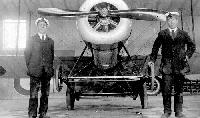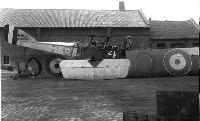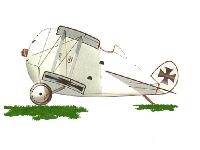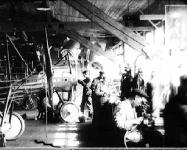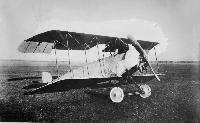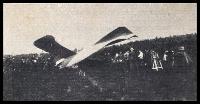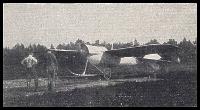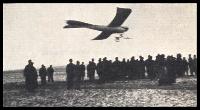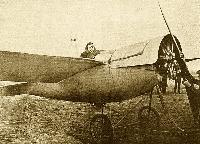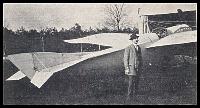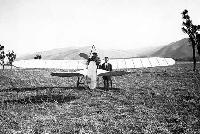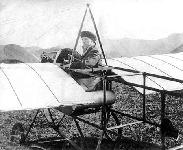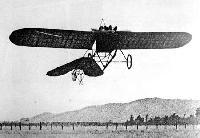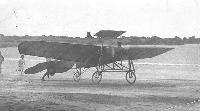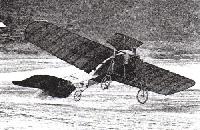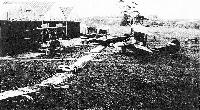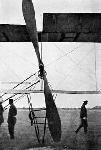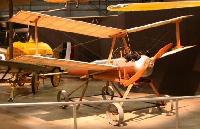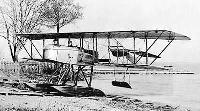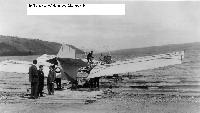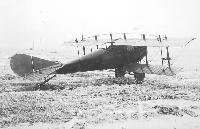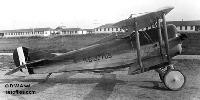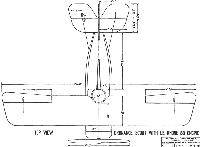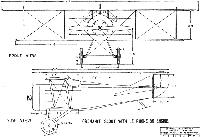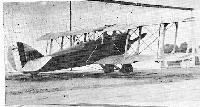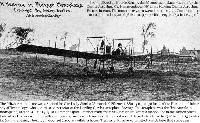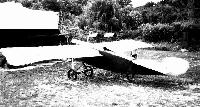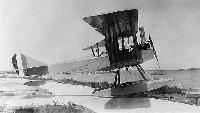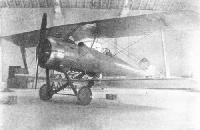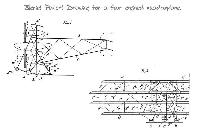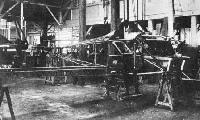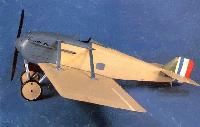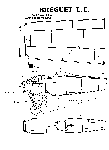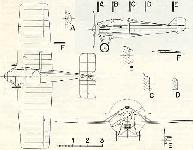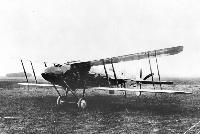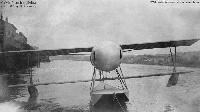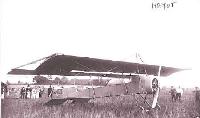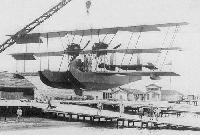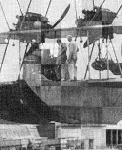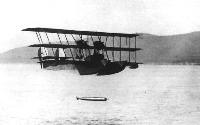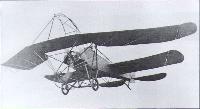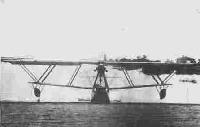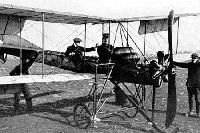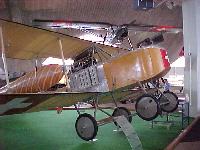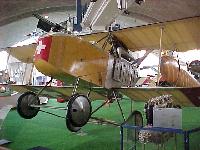Книги
WWW
Форум
Breguet's Aircraft Challenge
544
Форум - Breguet's Aircraft Challenge /WWW/
The machine was built by Stanko Bloudek and J. Cermak (I do not have his complete first name). Bloudek (1890-1959) was a brilliant engineer (Inzenir) who worked in world war one with the Osterreichische Flugzeugwerke. After the war he probably did all sorts of engineering things as two Austrian patents of him exist about closing mechanisms for train doors. He is probably most famous now because he initiated wintersports in the 1930's in Slovenia.
When the machine was constructed the state was obviously Austro-hungary, which country splittered after 1918 in several other, sometimes 'new' countries.
Basic data are Span: 27'10" Length: 29'6" Weight: 838 lb
When the machine was constructed the state was obviously Austro-hungary, which country splittered after 1918 in several other, sometimes 'new' countries.
Basic data are Span: 27'10" Length: 29'6" Weight: 838 lb
Etrich-Wels Gleiter Zanonia III (Austria 1907) A glider with wing shape inspired by the Zanonia seed. The seed's natural stability in flight inspired several pioneers of early aviation including Handley Page, Igo Etrich, John William Dunne and José Weiss.
Etrich-Wels "Etrich I" (Austria, 1907) Pusher monoplane with Antoinette 24 hp engine, tested in the fall of 1907, as shown in the original Etrich Taube brochure. Igo Etrich is in the pilot seat. Had a front elevator and control of the aircraft was for the first time using wing warping. The tests flights were performed at Vienna, Prater Square. For the start was prepared a rail starting ramp, but the aircraft was too heavy to fly. Designed by Igo Etrich and Franz Xavier Wels. Built at Oberaltstadt, near Trautenau (today Trutnov, Czech Republic).
In 1908 Igo Etrich carried out modifications and tests on his Etrich-I flying wing, which was equipped with a new two-wheeled landing gear, a propeller at the front and rudder at the rear. Another modification brought the aircraft a lattice fuselage with a steerable landing gear. Tests were started in October 1909 and it made its first successful flight on November 29, 1909, over the entire field at Weiner Neustadt. When the Clerget engine broke on December 14th, the tests were stopped.
Etrich VIII Luft-Limousine/Fluglimousine (Austria, 1912) The Etrich Limousine made its maiden flight on May 7, 1912 at Josefstadt, Austria. It was the first passenger aircraft with a completely enclosed seating cabin. Igo Etrich had established the "Aeroplan Bau Gewerbe" in his home town of Trautenau, and at the airfield in Josefstadt - only few kilometres south of Trautenau - developed his new constructions: the Taube-Limousine and Schwalbe. The airplane had very successful flight characteristics and made many flights.
Lohner Marineflieger III (K.u.k. Seeflugzeug Nr.3) (Austria, 1912) The third aeroplane of the Austrian navy, a "Pfeilflieger" biplane with a 120 hp Daimler Engine. Lohner was asked to develop a biplane for the Austro-hungarian navy in 1911 which was finished in March 1912 with a temporary undercarriage to be able to test on the land. Typical of the design was the high mounted propeller - driven by a chain - and the big wings (unequal span, 4 struts at a side).
Lohner Pfeilflieger Sporttype 1912 - or Type "Hold" (Austria-Hungary 1913) Of this light arrow-biplane with 85 hp Hiero engine two copies were built. One for the k.u.k. Luftfahrtruppe got the name "Cyklon". A second model (seen here) was sold to Herman Hold. It could be fitted with wheels or floats. This photo was taken when Hold flew the aircraft at the Adriatic See at Portorož (today Slovenia) in 1913.
Merćep-Rusjan EDA VI (Austria-Hungary [Croatia], 1910-1911) Monoplane built by the Rusjan brothers at the workshops of Mihajlo Merćep in Zagreb; completed sometime in Autumn 1910. Unfortunately, while promoting the upstart firm "Agramer Aëroplanfabrik M. Merćep" at Belgrad in January 1911, Edvard "Eda" Rusjan fell to his death when the wings collapsed on this machine.
Merćep 1912 aka Merćep-Rusjan Military-Monoplane of 1912 or Rusjan-Novak No.2 (Austria-Hungary [Croatia], 1912) Second design after the crash of the Slovenian aviation pioneer Eduardo Rusjan. Earlier, Eduardo had moved with his brother to Zagreb, Croatia, where Guiseppe Rusjan and Dragutin Karlo Novak then continued to built aircraft for the "Agramer Aëroplanfabrik M. Merćep", set up by businessman Mihajlo Merćep in Zagreb.
This is the Austro-Hungarian Grossflugboot G 6, built by Oeffag and designed by Josef Mickl, which was delivered in August 1916. The machine was considered a bad flyer, but did a raid to Venice in September 1916 together with the G 3. The bomb load that was carried was 600 kg.
Némethy "Flugrad" (Austria-Hungary [Romania], 1901) Designed and built by Emil von Némethy at his factory in Arad, Hungary (now in Romania). The construction of his Flugrad ("flying wheel" or "flying bicycle") started sometime in 1899, yet wasn't completed until 1901. A second machine appeared in 1903, pictured in a 1907 Scientific American article, and in 1910 produced a third and final original design. Némethy soon after however, gave up his experiments once his Anzani motor was damaged and he had run out of money.
The Austro-hungarian experimental Phonix 20.16 in its second version. The first version of this experimental had a sesquiplane and a completely filled fuselage to the upper wing, resulting that the pilot could see nothing straight ahead. He could look possibly over the upper wing a little bit, judging from pictures.
What we see here is the second version of the 20.16 which can be distinguished by its equal wings and the radiator on the leading edge of the top wing. There was also romm between the top wing and the fuselage to look straight ahead.
This experimental was judged ripe for production in August 1917, to become the Phonix D.I production fighter.
What we see here is the second version of the 20.16 which can be distinguished by its equal wings and the radiator on the leading edge of the top wing. There was also romm between the top wing and the fuselage to look straight ahead.
This experimental was judged ripe for production in August 1917, to become the Phonix D.I production fighter.
Soltau "Sturmvogel" Schwingenflieger (Austria-Hungary, 1909) The "Sturmvogel" was an ornithopter designed by Austro-Hungarian engineer Andreas Soltau. It was powered by a carbonic acid engine. It was a relative large machine, with a span of 11 meters and a wing area of 30 square meters. It had an elevator at the rear, a birdlike construction obviously, and the rudder in front. The machine was not successful, as the flapping had a too low frequency to lift it off. Tests were made at Linz on 16 August 1909, which were highly published in the contemporary Austro-Hungarian press. After his adventure with the Sturmvogel, Soltau left aeronautics, but he can still be traced in patents dating from the 1920s, one of which features a hot-air engine.
The Sturmvogel after the test, the flapping wings are distorted (although reportedly it could fly 25 times a minute)
UFAG C.I Series 161 prototype, 161.01 or 161.02, with a single I-strut, 1917. Observer's turret is missing too. Flars requested conventional wing struts.
The Warchalowski V ("Vindobona Racer"), was flown by the constructor on June 7, 1911. It was a development of the Warchalowski IV and was reported to have a single rudder and a Gnôme engine. Examples were built. Two Warchalowski V aircraft took top positions in the Air Meeting in Wiener-Neustadt (11-18.06.1911). On 9.08.1911, a night flight over Vienna was made on a plane equipped with headlights. The VI version was reported to have a single horizontal tail was used and a Daimler inline engine. In August and September 1911, three examples were built. On this plane, in August and September 1911, the constructor participated in military exercises. One was broken down by J. Sablatnig on October 1, 1911, a second was crashed by Sablatnig on August 19, 1911 during a flight around lower Austria, where he reached a speed of 106 km/h. The machine on the picture has features of both types...
Albert Ziegler, born in Zeiden (today Codlea) next to Kronstadt (Braşov), Transylvania, worked as an engineer in the motor and aviation business in Switzerland, France and England before coming to Germany in 1911. There he assisted Prinz Sigismund von Preußen in building a glider, and was employed by Rumpler, Wright and Garuda. In 1912 Ziegler acquired a used 50–55 hp Argus engine and a shed at the Bornstedter Feld near Potsdam from the Siemens-Schuckert company, where at least a year was needed to realise his "Pfeil-Eindecker". Flown during the summer of 1913, it was said to be very stable and well steerable.
Castaibert built about 20 machines of several types between 1910 and 1916 when he gave up the business. The IV was powered by a 50 hp Gnome and had a reported top speed of 100 km/hr.
First Bulgarian Airplane
In the Aeroplanno Otdelenie division, Assen gained expertise, he designed the first Bulgarian-made airplane, and it was built in the summer of 1915. Jordanoff test flew the plane, and it was subsequently named the Diplane (biplane) Jordanoff-1. August 10th, 1915, was considered as the beginning of Bulgarian aircraft industry. Jordanoff already became known as designer, mathematician, and inventor at his young age. He introduced a valuable new device, namely a feature which prevents the plane from losing altitude, into the new plane.
Assen Jordanoff's airplane was at a first look similar to the planes of that time. It was a biplane with relatively short wings, to decrease the body weight and with increased spacing between them to improve the aerodynamic effect of the lower wing. The wing section was similar to that of Albatros. The cockpit and the fuselage were conceived with great care to diminish drag. The landing gear was reinforced with double tires for stability and safety when landing. The tail, vertical and horizontal stabilizers and the ailerons were similar to those built by Louis Bleriot. The innovation that helped at landing and at recovery from stalls was something like contemporary flaps, added between the wings.
Jordanoff was awarded a scholarship to study abroad for his construction. His next and even more ambitious project was a heavier multi-engine plane. Unfortunately the rise of World War I cancelled his plans.
First test flight being performed on 7 August 1915 by pilot Gavril Stoyanov. Several "official" flights by Captain Radul Milkov (Aeroplane Section CO) on 10 August 1915.
Another Bulgarian design crashed during first test flight on 15 July 1915 killing its designer and a passenger.
In the Aeroplanno Otdelenie division, Assen gained expertise, he designed the first Bulgarian-made airplane, and it was built in the summer of 1915. Jordanoff test flew the plane, and it was subsequently named the Diplane (biplane) Jordanoff-1. August 10th, 1915, was considered as the beginning of Bulgarian aircraft industry. Jordanoff already became known as designer, mathematician, and inventor at his young age. He introduced a valuable new device, namely a feature which prevents the plane from losing altitude, into the new plane.
Assen Jordanoff's airplane was at a first look similar to the planes of that time. It was a biplane with relatively short wings, to decrease the body weight and with increased spacing between them to improve the aerodynamic effect of the lower wing. The wing section was similar to that of Albatros. The cockpit and the fuselage were conceived with great care to diminish drag. The landing gear was reinforced with double tires for stability and safety when landing. The tail, vertical and horizontal stabilizers and the ailerons were similar to those built by Louis Bleriot. The innovation that helped at landing and at recovery from stalls was something like contemporary flaps, added between the wings.
Jordanoff was awarded a scholarship to study abroad for his construction. His next and even more ambitious project was a heavier multi-engine plane. Unfortunately the rise of World War I cancelled his plans.
First test flight being performed on 7 August 1915 by pilot Gavril Stoyanov. Several "official" flights by Captain Radul Milkov (Aeroplane Section CO) on 10 August 1915.
Another Bulgarian design crashed during first test flight on 15 July 1915 killing its designer and a passenger.
The Bulgarian aircraft building traces its origins from early 1915 when the aviation technician Ilya Mladenov and the pilot Stefan Kalinov built an aircraft by their own design named Dogan, which was similar to the French-made Voisin. However, their undertaking was unsuccessful as Dogan crashed during its first test flight killing the pilot Stefan Kalinov.
It is the Tomisch biplane that he named "Condor". Tomisch was in South America at the outbreak of the war and stayed on working for Sanchez-Besa in Chile before going to Bolivia.
The description gives that the machine was driven by an Argus engine of 180 hp.
The description gives that the machine was driven by an Argus engine of 180 hp.
Avro 504 experimentally fitted with a four-bladed propeller and experimentally fitted with ailerons on the upper and lower wing.
A special wing built by Armstrong Whitworth based on the Phillips entry (?) principle was fitted to Bristol T.B.8 No.1227 which after the deletion of the machine (21 June 1916) were fitted to T.B.8 No. 1217.
The RNAS had a requirement for a two-engined bomber and sent representatives out to France to investigate the possibilities. The idea was to produce a two-engined Henry Farman or a Nieuport design powered by two 110 hp Clergets. Brush produced the first of an order for twin-engined Farman Astrals. After trials of the first one at Hendon which were unsuccesfull, the rest of the order was cancelled.
The single example had the serial 9251 (the rest of the order 9252-9260 was cancelled) and was powered by two 100 hp Anzani engines. No markings are visible on pictures, only on the fuselage can be seen the falcon-crested badge of Brush (almost invisible in the original picture in the magazine, this is the 'dot' almost at the nose).
The single example had the serial 9251 (the rest of the order 9252-9260 was cancelled) and was powered by two 100 hp Anzani engines. No markings are visible on pictures, only on the fuselage can be seen the falcon-crested badge of Brush (almost invisible in the original picture in the magazine, this is the 'dot' almost at the nose).
A German captured Martinsyde Elephant disassembled and ready for transport. No German markings are yet applied, but the English serial A1572 is still present.
This is a post-war picture of the Canadian Norman Thompson N.T.2B which carried the (then) Canadian registration G-CAEL. The machine is (extensively ?) modified, at least the typical upper wing structure is absent. Possible other modifications. The machine must have been one of the large number of war-surplus Nroman Thimpson N.T.2b planes, used in Canada in the barnstorming years.
The Port Victoria P. V. 8, also known as The Eastchurch Kitten. It was designed by Henry Busteed of the Experimental Flight at Eastchurch as a lightweight ship-based scout. It is sometimes mis-identified as the Sopwith Kitten. This may be because of the close association of Busteed with the Sopwith Company and fellow Aussie Harry Hawker, and also due to the use of the "Tripe-like" plank style interplane struts.
It is the second machine, powered by the RR engines, which gave an improved, but still poor performance.
Royal Aircraft Factory N.E.1 original version with searchlight in the nose. N.E. stood for Night-flying Experimental.
A Robey-built Short 184 with 240 h.p. Renault engine, seen with wings folded and on beaching trolley.
The picture is one of a sequence of three taken that show Captain Vernon Brown looping Sopwith Triplane N5430 at Ordfordness. Taken by a Lt. Hammond from a Sopwith 1-1/2 Strutter. The camera used could make one exposure per second.
The Herbert Spencer biplane made its mark in WW1 because it was acquired by the Admiralty in September 1914, where it got the No.200. The machine lasted till mid-May 1915, when it was abandoned. The machine was probably used as a trainer.
This is the Watson No.3 Rocking wing aeroplane flying on June 18, 1914 at the Concours de la Securite en Aeroplane in Paris. Incidentally Watson himself was not flying in Paris, because he had no pilot's licence. He obtained a licence in 1915. Flying was Mr. S. Summmerfield, who had a pilot's licence and regularly flew Bleriot monoplanes in England.
The Allgemeine Elektrizitäts-Gesellschaft decided in 1910 to start an aeroplane department [Abteilung Flugzeugbau] at Berlin-Hennigsdorf. At the beginning they had no knowledge of design and production methods for aircraft, so as other firms they started with analyzing a proven machine. They chose a Wright biplane. After analyzing it they realized the limitations of building aircraft in wood. To gain experience in designing and building metal machines they decided to start with a research machine which was the responsibility of chief designer Oberingenieur Paul Stumpf. The design was an open-fuselage all-metal tube construction of large dimensions, with a span of 17.5 m. It was a single-seater, with the pilot placed in the open aft of the wings. In front of the wings a small platform construction held the 75 hp Körting engine, which drove a tractor propeller mounted in the middle of the wings via a chain. The factory identification was Z.1, with Z for Zweidecker (Biplane). Later designs is this series went at least till Z.10.
This machine is from the AGO (Aviatik Gustav Otto)-Flugzeugwerke from Berlin-Johannisthal. This machine is commonly known as Militardoppeldecker (Military biplane) with Argus engine. The machine has bar-structured tailbooms (German : 'Gitterrumpf') with front-wheels and an MG in the front. Machine was an experimental type from 1914.
AGO built during the same time a Seedoppeldecker - the same type on floats - which was more succesfull. Five of these were actually bought by the German Marine, No. 65-69.
AGO built during the same time a Seedoppeldecker - the same type on floats - which was more succesfull. Five of these were actually bought by the German Marine, No. 65-69.
Albatros Doppeldecker type, quite likely a training machine, given the skids and the apparent comfort provided to the instructor in back. Its 6-cylinder engine was either a Daimler Mercedes D.I or D.II of 100 or 120 hp. Very similar to the Albatros "Uhu" Schuldoppeldecker (training biplane) dating from 1913, described by Lange as having many of the same qualities.
A neatly streamlined three-seat float-equipped monoplane with 100 hp Mercedes engine. It was flown by Hellmuth Hirth in the October 1913 Gran Premio dei Laghi, which was a race around several Italian lakes around Como.
Aviatik Schul-Doppeldecker (Germany, 1912) Of a type usually powered by 50–70 hp Argus engines, this particular machine was the first Aviatik biplane that received a 100 hp engine. In November 1912 aviator Arthur Faller planned to perform a promotion flight from Habsheim to the "Feldberg", the highest mountain in the Black Forest, but while waiting for suitable weather conditions he undertook several record-breaking multiple-passenger flights. One such flight took place on January 30, 1913 at Flugplatz Habsheim carrying three passengers, lasting 2 hours and 3 minutes, breaking the standing world-record of 1 hour and 35 minutes set on January 25, 1912 by Dipl.-Ing. Grulich on a Harlan Eindecker, yet others with 3, 4, 5 and 6 passengers followed or predated that event.
Aviatik Versuchs-Doppeldecker (Germany, 1910)
Experimental first machine designed and built by Julius Spengler (founder of Aviatik GmbH in Mülhausen-Burzweiler / Elsass). Notable for its twin triple-superimposed propellers driven via chains by a 50 hp Argus engine in the wings, and its unique undercarriage.
Experimental first machine designed and built by Julius Spengler (founder of Aviatik GmbH in Mülhausen-Burzweiler / Elsass). Notable for its twin triple-superimposed propellers driven via chains by a 50 hp Argus engine in the wings, and its unique undercarriage.
Alexander Baumann (1875-1928) built the challenge machine with the support of the manufacturer Ernst Emil Freytag in 1912/13. Contrary to Bauman's plans, structural changes were made to the aircraft, so that a test flight ended with the crash and death of the test pilot. For the first time, Baumann used a self-inflating wing profile similar to that of today's paragliders on this aircraft. After the outbreak of the First World War, Baumann constructed functioning giant aircraft. By the end of the war, 34 of these aircraft had been built, including 18 Zeppelin-Staaken R VI. In 1925 he moved to Mitsubishi in Japan as chief designer. His family returned to Stuttgart in mid-1927. He himself followed at the end of the year, but found his wife with leukemia. About two months after her rapid death, he died on March 23, 1928 of nicotine poisoning.
This is the elusive Beese-Boutard Flugboot designed by the German aviatrix Melli Beese and her husband the Frenchman Charles Boutard. Only this drawing / sketch is available for this machine.
The construction of this flying boat was unique as the hull had a special double construction (twin hull). Each part of the hull had the full capability of floating the entire Flugboot.
It is said in many articles that the machine was patented, but hours of searching have not returned any Patent of Beese-Boutard's Flugboot unfortunately.
The machine was powered by a 100 hp Mercedes engine driving a pusher propeller. Length 9,20 meter, Span 15,90 meter, Height 3,48 meter.
Owing to the boat form no stabilizers were mounted at the end of the wing. The upper wing had a distinct Taube form.
The machine was definitely built and entered for the Ostsee-Wasserflug-Wettbewerb in Warnem?nde from 1 August 1914 till 10 August 1914, which eventually was called off during the day of 1 August 1914. Twenty-six (26) machines (almost all floatplanes) were entered for this competition, presumably all German (given the patriotic times ...). There were two other flying boats entered, specifically from Rumpler and AEG.
As said, the famous Hermann Dorner [1882 - 1963 ] helped out with the design of the machine. Beese had already designed a Taube like machine in 1912. I think it will never be known how much Beese - Boutard - Dorner each did with the design, but I think that Dorner had a consulting part in it as he already had his own Dorner Flugzeug GmbH, which folded in 1912. At the end of 1915 Dorner was chief designer of the Riesenflugzeugabteilung of the Deutschen Flugzeug-Werke (DFW) in Leipzig-Lindenthal. From 1916 till the end of WW1 he was chief constructor of engine development (Flugmotorenentwicklung) in the Hannover Waggonfabrik, Abteilung Flugzeugbau, in Hannover-Linden (Hawa). A great career.
His remaining archive is held in the Deutsches Museum. Possibly it has a shred of information about this Flugboot.
As said Beese and Boutard were interned as foreign citizens in the beginning of august 1914. According to sources the Flugboot rottet away in Warnemunde, the place where it was built by the Jachtwerft Oertz.
The construction of this flying boat was unique as the hull had a special double construction (twin hull). Each part of the hull had the full capability of floating the entire Flugboot.
It is said in many articles that the machine was patented, but hours of searching have not returned any Patent of Beese-Boutard's Flugboot unfortunately.
The machine was powered by a 100 hp Mercedes engine driving a pusher propeller. Length 9,20 meter, Span 15,90 meter, Height 3,48 meter.
Owing to the boat form no stabilizers were mounted at the end of the wing. The upper wing had a distinct Taube form.
The machine was definitely built and entered for the Ostsee-Wasserflug-Wettbewerb in Warnem?nde from 1 August 1914 till 10 August 1914, which eventually was called off during the day of 1 August 1914. Twenty-six (26) machines (almost all floatplanes) were entered for this competition, presumably all German (given the patriotic times ...). There were two other flying boats entered, specifically from Rumpler and AEG.
As said, the famous Hermann Dorner [1882 - 1963 ] helped out with the design of the machine. Beese had already designed a Taube like machine in 1912. I think it will never be known how much Beese - Boutard - Dorner each did with the design, but I think that Dorner had a consulting part in it as he already had his own Dorner Flugzeug GmbH, which folded in 1912. At the end of 1915 Dorner was chief designer of the Riesenflugzeugabteilung of the Deutschen Flugzeug-Werke (DFW) in Leipzig-Lindenthal. From 1916 till the end of WW1 he was chief constructor of engine development (Flugmotorenentwicklung) in the Hannover Waggonfabrik, Abteilung Flugzeugbau, in Hannover-Linden (Hawa). A great career.
His remaining archive is held in the Deutsches Museum. Possibly it has a shred of information about this Flugboot.
As said Beese and Boutard were interned as foreign citizens in the beginning of august 1914. According to sources the Flugboot rottet away in Warnemunde, the place where it was built by the Jachtwerft Oertz.
A drawing of the Dorner Flugboot in the German Zeitschrift fur Flugtechnik und Motorschiffahrt (ZFM) Volume 1914 Number 9 (16 May 1914).
This simple high-wing monoplane with its characteristic tuning-fork like steel-tube fuselage was the first aircraft built by the BMFW (Bayerische Motoren- und Flugzeugwerke) in Nürnberg. It is also known as Philipp Enders monoplane. Enders was manager of the BMFW and equipped his first monoplane with a three-cylinder engine of own design.
BMFW built a monoplane with a spindle-shaped steel fuselage. It was powered by its own 70 hp Sylphe rotary motor with German Integral propeller. The motor weighed only 58 kg, i.e. approx. 1 kg/hp.
Militäreindecker [Military monoplane] designed by Ing. Philipp Enders [System Enders] announced in Flugsport 1911 to be constructed by the Flug Technische Gesellschaft Nürnberg-Fürth E.V., yet in the same issue a drawing infers that it is to be constructed by the Nürnberger Motoren und Maschinenfabrik. In the end the steel-constructed machine was exposited in the Berlin ALA (Algemeinen Luftfahrt Ausstellung) 1912 as a finished machine of the Bayerische Motoren- und Flugzeugwerke Nürnberg. The machine can easily be distinguished by its high mounted wing, connected to a very small iron 'rudder bearer'. The pilot and the passenger are seated beneath the wing in a comfortable gondola, with windscreen.
Militäreindecker [Military monoplane] designed by Ing. Philipp Enders [System Enders] announced in Flugsport 1911 to be constructed by the Flug Technische Gesellschaft Nürnberg-Fürth E.V., yet in the same issue a drawing infers that it is to be constructed by the Nürnberger Motoren und Maschinenfabrik. In the end the steel-constructed machine was exposited in the Berlin ALA (Algemeinen Luftfahrt Ausstellung) 1912 as a finished machine of the Bayerische Motoren- und Flugzeugwerke Nürnberg. The machine can easily be distinguished by its high mounted wing, connected to a very small iron 'rudder bearer'. The pilot and the passenger are seated beneath the wing in a comfortable gondola, with windscreen.
This twin-100 h.p. Oberursel U I powered single-seat fighter was designed to carry a Becker cannon.
Flugzeug- und Explosionsmotoren-Gesellschaft (F.E.G.) Eindecker, designed by Leutnant Coler. Sometimes the machine is named System Coler. I never found anything about the mysterious Leutnant Coler. Characteristics of the machine are the landing gear with two big wheels and a small anti-nose over wheel in front (here invisible) and the form of the elevator. In flight picture was one in a series made at Johannisthal during the Herbst-Flugwoche 1912 [29.IX.1912 - 6.X.1912]
Pteranodon with 55 hp 4-cylinder Basse & Selve. [1914]
This was the third and last aeroplane designed by the Polizeikommissar von Klosterlein at the Condor-Flugzeugwerft in Köln-Niehl. The Pteranodon, named after a flying dinosaur, was built in 1912 or 1913 and was powered by a 55 hp Basse & Selve engine.
This was the third and last aeroplane designed by the Polizeikommissar von Klosterlein at the Condor-Flugzeugwerft in Köln-Niehl. The Pteranodon, named after a flying dinosaur, was built in 1912 or 1913 and was powered by a 55 hp Basse & Selve engine.
Arthur Delfosse (1883-1956) built his first motorcycle at the age of 15. In 1902 he made his first gliding experiments on the Mülheimer Heide in Cologne with a homemade airplane. In 1909 Delfosse built the challenge monoplane, a Blériot-like machine with metal fuselage, powered by one of his own 24 hp three-cylinder engines. He displayed it at the Cologne aviation week and the Brussels Motor Show. Subsequently he founded the first aircraft engine factory in Germany.
The photo shows the Argus-powered monoplane as flown by Alfred Behrend at the 1. Internationale Flugwoche, 10-16 May 1910 in Johannisthal. It was designed by Willi Schultze-Herfort and built in Rummelsberg, near Berlin.
The Dorner monoplane was a well-known sight around Johannistahl. Georg Schendel set a German record for altitude of 2010 meters on 6 June, 1911, and a World Altitude record with passenger, of 1690 meters on 9 June, 1911, in his Dorner. Type II had a 20 hp Dorner-Motor and cost 13,500 Marks. Type III came with a 40 hp Dorner-Motor at 15,500 Marks, or 50 hp at 16,500 Marks. The T. III version had a fatal accident for both passenger and pilot on 9 June, 1911 at Johannistahl. The photo is scanned directly from the Original 1912 Dorner Company brochure.
This machine was praised by Oskar Ursinus of the german magazine Flugsport for its beautiful lines.
The machine was a private venture of the Euler firm, which was later developed in the Euler B.I, bought by the German Army. The machine looks on the picture as just rolled out of the factory. There exists even another picture from the same machine showing it from 3/4 from the front.
Later Euler produced the B.I, B.II and B.III as developments from this machine. The B.I etc. were official designations given by the Idflieg when the machines were acquired.
The picture of the 6 produced machines are surely the developed Euler B.I machines. This is another picture of the row of Euler machines under construction, but then at an earlier stage.
The machine was a private venture of the Euler firm, which was later developed in the Euler B.I, bought by the German Army. The machine looks on the picture as just rolled out of the factory. There exists even another picture from the same machine showing it from 3/4 from the front.
Later Euler produced the B.I, B.II and B.III as developments from this machine. The B.I etc. were official designations given by the Idflieg when the machines were acquired.
The picture of the 6 produced machines are surely the developed Euler B.I machines. This is another picture of the row of Euler machines under construction, but then at an earlier stage.
Euler C.I 3628/15 or 3626/15 as a trainer. The picture is from the album of Lt. Oliver Lux who was at FEA 10 in march/april 1918.
This monoplane was built at the "Erste Deutsche Automobil-Fachschule , Abteilung Flugtechnik" at Zalbach near Mainz , where Anthony Fokker was student . Depending on whose research you trust, this monoplane was either designed and built by Fokker and another student, Franz von Daum, with help from the engineers of the school, or taken over as an unfinished project by Fokker and von Daum. Anyway, the monoplane which was finished in October 1910, with von Daum bringing most of the money and a 50 hp Argus engine. It was tested by Fokker, and first hop made in December 1910. Later, von Daum damaged it beyond repair. Again, depending on who you trust, Fokker and von Daum decided to build a new monoplane, this time designed with much help from Goedecker and built at the Goedecker plant, this machine being the first Fokker Spinne, or the challenge machine was finished at the Goedecker plant and actually became the first "Spinne".
This is (an enlarged) still of the start of a movie shot in the experimental section of the Schwerin works of Fokker. At the right can be seen the craftsmen, probably the best of the Fokker factory. At the left in front you see the uncovered nose of the Fokker V.2 with in the background the covered fuselage of the Fokker V.1.
A modified Fokker D.VII two-seater powered with a Packard engine on McCook Field. The machine lasted at least to 1922.
The first form of the first Friedrichshafen model, FF 1, distinguished by its central float concept, pusher construction, 3-bay wing and old-style ailerons between the wings.
This was the first design of Friedrichshafen, in its original version with unequal span wings. It was a pusher biplane with a central float construction and small floats at the wing tips and a small float at the tail end. There were ailerons fitted between the wings. The initial flight was in November 1912. The engine was an Argus water-cooled engine rated at 100 hp. Piloted by the company's test pilot, Robert Gsell, on 14 February 1913, the FF.1 set a German national flight endurance record of 2 hours, 32 minutes, and 30 seconds. It was destroyed in a crash in February 1914.
Garuda S.11 Möwe (Germany, 1913)
In 1913 the Garuda Flugzeug- und Propellerbau GmbH in Berlin-Neukölln built two monoplanes, inspired by the Geest monoplanes. One was the challenge machine, powered by a 100 hp Argus engine and the other, shown at the ALA Berlin, was the quite different Militärtype H.12 Möwe.
In 1913 the Garuda Flugzeug- und Propellerbau GmbH in Berlin-Neukölln built two monoplanes, inspired by the Geest monoplanes. One was the challenge machine, powered by a 100 hp Argus engine and the other, shown at the ALA Berlin, was the quite different Militärtype H.12 Möwe.
A construction of "Gesellschaft für Flugmaschinen- und Apparatenbau" at Bonn-Hangelar; designed and built by Dr. Josef Hoos - a "Kölner" - and a flyer since 1911. Similar monoplanes were built in "some" numbers during 1910-1913, with various engines and used by the Hoos flying school up until 1914 - at first in Cologne and from December 1913 in Bonn-Hangelar. The earlier G.E.F.A. eindeckers (of 1911/12) had a small rudder, the later rudders were larger. This example, probably a later model with a partially covered fuselage, is shown at Hangelar Flugplatz in early 1914 with flight-student Albert Leick seated.
Goedecker "Taube" (Germany, 1910-1912) The second design of Jacob Goedecker, powered by an Argus engine. The typical "Taube" with twisted "Zanonia" wings was first flown in 1910 and appears on a postcard advertising flights of the Swiss pilot Josef Schumacher in 1912.
Goedecker Flugboot Amphibium (Germany,1912) Second Amphibium, or "Amphibium II", constructed by the Jacob Goedecker Flugmaschinen-Werke in 1912. At the end of August 1912 Goedecker flyer Bernard de Waal took the newly developed "Amphibium" to the First German Seaplane Competition in Heiligendamm district. Due to technical problems the Goedecker flying boat achieved only 4th place in a field of 6 participants. A second flying boat with a more powerful engine was built and tested at the Mainzer Floßhafen, and stationed in a boathouse. In a strong storm on April 6, 1913, the "Amphibium II" was severely damaged and scrapped.
This machine was built by the Gothaer Waggonfabrik AG, Abteilung Flugzeugbaur, Gotha in 1913. This four-bay (Vierstielig) rigger-nightmare machine was designed in 1913 by one of the designers of Gotha, Dipl.-Ing. Bruno Buchner. Most - or all - of our contestants saw a three-bay machine in it.
The span of the machine was 20 meter, with the lower wing being constructed "loose" from the fuselage. Power was provided by an Argus As II of 120 hp, driving a two bladed propeller.
Obviously the machine was in use as a trainer (Schuldoppeldecker) for the German Marine, looking at the uniforms.
The span of the machine was 20 meter, with the lower wing being constructed "loose" from the fuselage. Power was provided by an Argus As II of 120 hp, driving a two bladed propeller.
Obviously the machine was in use as a trainer (Schuldoppeldecker) for the German Marine, looking at the uniforms.
Gotha-Büchner Schuldoppeldecker (Germany, 1913) Designed by Bruno Büchner, powered by a 120 hp Argus, this stable biplane with huge warping wings (20 m span) was built by Gothaer Waggonfabrik.
The machine is the Gotha LD 5 a 'mini' plane for quick scouting ('Kavallerie Flugzeug') developed in november 1914.
Although initially designed as a high performance two seater, the Gotha LD-5 was rejected for field service as other than a single seat advanced trainer and even in this role, its small wing area and consequent high wing loading would ensure that it was confined to operating from the longest of available airstrips. First flown in December 1914, the LD-5 used a 100hp Oberursel Ur I, but no other useful performance data survives. The real mystery surrounding the LD-5, however, is how Gotha were permitted to build no less than 13 of these fairly pilot-unfriendly looking brutes.
Although initially designed as a high performance two seater, the Gotha LD-5 was rejected for field service as other than a single seat advanced trainer and even in this role, its small wing area and consequent high wing loading would ensure that it was confined to operating from the longest of available airstrips. First flown in December 1914, the LD-5 used a 100hp Oberursel Ur I, but no other useful performance data survives. The real mystery surrounding the LD-5, however, is how Gotha were permitted to build no less than 13 of these fairly pilot-unfriendly looking brutes.
Hans Grade built this machine during his military service with the Magdeburg pioneers. At the end of September 1908, the first roll tests began on the Cracauer Anger outside Magdeburg. About a month later, on 2 November 1908, he made the first German powered flight. He reached by the end of the year flights at 1.5 meters altitude over 100 to 400 meters in 30 to 40 seconds, essentially straight ahead. In 1909, he decided to finish the experiments and build a new aircraft, based on the experience gained. This new monoplane won him the Lanz Prize on October 30, 1909. A replica of the machine can be found at the Technikmuseum Magdeburg.
At the 1912 Allgemeine Luftfahrzeug-Ausstellung in Berlin, Hans Grade displayed two new monoplanes, with a "normal" fuselage, egg-shaped and tapering into a flat tail, instead the usual gondolas of his previous airplanes. One was a "Renneindecker", identified by Bruno Lange as the D type, with a 30/45 hp Grade engine. The other was this machine, the bigger "Militäreindecker" with a 60/90 hp Grade engine, type E according to Lange.
On the right , the Renneindecker described by Bruno Lange as the "D" type , with a 30/45 hp Grade engine.
On the left , the "bigger" Militäreindecker with a 60/90 hp Grade engine , type "E" if we refer to B.Lange.
On the left , the "bigger" Militäreindecker with a 60/90 hp Grade engine , type "E" if we refer to B.Lange.
ZM II or Hansa Brandenburg Type GF, developed from the Type ZM originally built for the German Navy. The machine got the Austro-hungarian registration 05.05.
Bruno Hanuschke built a glider with the help of his brother Willi. His first powered plane, which looks much like the glider but powered by a two-cylinders engine, was built (when as he was 18) in 1910 at Johannisthal. This biplane made only short hops.
Hanuschke Eindecker "Populaire II" (Germany, 1912) German monoplane distinguished by its completely bare triangular tube fuselage fitted with a 50 hp rotary Gnôme engine.
Fritz Heidenreich's Grade-like Eindecker No. 1 was displayed at the Flugmaschinen-Ausstellung des Schlesischen Flugsport-Club in 1910. It was originally powered by a 30 hp Weiland & Gildemeyer engine and later by a Grade.
Heinrich Heitmann started gliding experiments in Bresleu before moving back to Hamburg-Altona. His company built eight different types between 1909 and 1912, the fourth was this Grade-like monoplane with a Delfosse engine. According to "Motorwagen" 1911, it flew successfuly on the Wandsbecker Exerzierplatz.
The Hubner Eindecker IV, stored away in WW1 in a brewery and rediscovered in 1980, now, after restauration in 1983, on display in the Technik Museum Sinsheim.
The designer Dr. Hugo Hubner was a director of a brewery, most likely in Mannheim-Mosbach. There is some reason that this machine was preserved in a brewery (space in the loft enough I think).
Hubner built 4 different machines in all, of which this one is the fourth. The Monoplane Type IV was powered by a 100 PS Argus engine, fitted in a metail tube fuselage construction. Radiators were fitted at both sides of the fuselage.
Span is 13 meter, maximum speed was 110 km/hour.
Achim Engels has taken on the effort to make detail drawings of the machine.
The designer Dr. Hugo Hubner was a director of a brewery, most likely in Mannheim-Mosbach. There is some reason that this machine was preserved in a brewery (space in the loft enough I think).
Hubner built 4 different machines in all, of which this one is the fourth. The Monoplane Type IV was powered by a 100 PS Argus engine, fitted in a metail tube fuselage construction. Radiators were fitted at both sides of the fuselage.
Span is 13 meter, maximum speed was 110 km/hour.
Achim Engels has taken on the effort to make detail drawings of the machine.
The unqiue Paul Jaritz monoplane built in 1913 / 1914, only one built. First flight in 1914. This comes from a book (1981) by the same Reinhard Keimel who does not state that this was the second Jaritz plane.
The machine was exposited on Easter Sunday April 12, 1914 and probably the next day also. Which dates the picture.
The machine was exposited on Easter Sunday April 12, 1914 and probably the next day also. Which dates the picture.
Jatho Doppeldecker "Motordrachen" (Germany, 1903)
Powered by a 9–12 hp Buchet motor, belt-drive pusher propeller, rebuilt from Karl Jatho's earlier Dreidecker, which had been damaged on August 21, 1903.
Powered by a 9–12 hp Buchet motor, belt-drive pusher propeller, rebuilt from Karl Jatho's earlier Dreidecker, which had been damaged on August 21, 1903.
Jatho Doppeldecker "Motordrachen" (Germany, 1903) Powered by a 9-12 hp Buchet motor, belt-drive pusher propeller, rebuilt from Karl Jatho's earlier Dreidecker, which had been damaged on August 21, 1903.
Jeannin Eindecker (Germany, 1912) This monoplane, powered by an Argus engine, was the first built by Alsatian pilot Emil Jeannin after moving to Berlin/Johannisthal to try his luck as airplane constructor.
Jeannin Eindecker Typ A (Germany, 1912) The first of Emil Jeannin's monoplanes, this design was the basis for all Jeannin's Eindecker before the Stahltaube. It was sold with a 50/70 hp Argus, like the one on the Challenge machine, or a Gnôme engine.
The Junkers Parasol J6 with Siemens Sh III rotary engine of 160 hp was an extremely small machine. It was completely built but remained in the workshop. Famous fighter aces were delighted to see the machine and wanted to fly it. In august 1918 Lt. Gotthard Sachsenberg asked Junkers when the machine would be ready to fly.
The very high landing was necessary by the use of a relatively great diameter of 2,8 meter. The petrol (and oil ?) was carried in a detachable tank beneath the fuselage.
The very high landing was necessary by the use of a relatively great diameter of 2,8 meter. The petrol (and oil ?) was carried in a detachable tank beneath the fuselage.
A thirteen meter span monoplane - with which two passengers could be carried beneath the pilot - built by Oswald Kahnt in Leipzig-Lindenthal. Kahnt was taught to fly by Hans Grade and opened the "1. Sächsische Fliegerschule" in Leipzig. Apart from some Grade machines, he built this monoplane during 1911. The power-plant used was initially a 45 hp Oerlikon; later a 70 hp Schröter inline engine was installed. With his "Falke" (Falcon), Kahnt flew over the "Völkerschlachtdenkmal." As head pilot at the Gothaer Waggonfabrik during the war, he was killed in a crash.
Karl Krieger (1885-1918) was a chauffeur for the "Kaiserin". Very interested by aviation, he settled in Johannisthal, where he built five monoplanes between 1910 and 1913, financially helped by the Kaiser. Krieger closed his workshop in 1915 and became pilot at Germania-Werke, where he crashed to death in 1918.
A swept wing, single engine, two seat biplane built in 1914 by the Luft-Fahrzeug-Gesellschaft in Reinickendorf (Berlin). Before the outbreak of World War I Bernard Langer flew a the machine shown by the challenge photo, equipped with a 100 hp Mercedes D.I engine and an extra tank above the fuselage in place of the passenger, on a non-stop sixteen hour flight. During WW1 at least one Pfeilflieger served with the Schutztruppe (Protection Force) in German South West Africa, now Namibia, between 1914 and 1915.
The picture (Sanke postcard No. 194) shows Paul Fiedler posing before the L.F.G. Roland Stahltaube which competed in the Rundflug um Berlin competition held from 30-31 August 1913. His machine had competition number 18 but was not very successful, as the final list given the timings for the different competitors does not include Fiedler. The L.F.G. Roland Stahltaube was one of the first models produced by the firm, being heavily modelled on the Etrich Taube. It was the firm's only Taube based model, although several versions seem to have been built.
Automobil-Fachschule Mainz Doppeldecker (Germany, 1911)
The Mainz Motor School airplane, known as the “One and a Half Decker” was built at the German Motor School at Mainz, Germany. The upper wing of this two-decker had 10 m span, the lower deck 7 m. The 50 hp Argus engine was placed in the front of the fuselage and drove the pusher propeller by means of a transmission. In the gondola-like cockpit there was space for the pilot and two passengers. Radiators were fixed on both sides of the fuselage.
The Mainz Motor School airplane, known as the “One and a Half Decker” was built at the German Motor School at Mainz, Germany. The upper wing of this two-decker had 10 m span, the lower deck 7 m. The 50 hp Argus engine was placed in the front of the fuselage and drove the pusher propeller by means of a transmission. In the gondola-like cockpit there was space for the pilot and two passengers. Radiators were fixed on both sides of the fuselage.
"Sport Eindecker ohne Seitensteuer" (sport monoplane without vertical tail plane), built by Bernard Mrozinski (of Polish birth), Berlin-Wilmersdorf. Length 7 m, span 10 m, area 20 m2, Weight 300 kgs, Motor 20 h.p. Anzani. It flew in 1912.
Oertz Biplane - 1910
The first machine from the Oertz Yacht Company, designed and built by the Oertz firm. Contrary to the Wright and Farman machines it had the elevator at the tail. Machine first flew in February 1910. Power was a four-cylinder Korting of 37 hp. See the picture, it did fly !
The first machine from the Oertz Yacht Company, designed and built by the Oertz firm. Contrary to the Wright and Farman machines it had the elevator at the tail. Machine first flew in February 1910. Power was a four-cylinder Korting of 37 hp. See the picture, it did fly !
Jachtwerk Max Oertz in Neuhof-Reiherstieg near Hamburg produced Wright machines. They then built the rather obscure machine, a Doppeldecker with uncovered fuselage, pusher propeller and landing skids without wheels, before another more well-known biplane. They built several flying boats and eventually sold the business to Hansa-Brandenburg in 1917.
Henri Wijnmalen circling the flying field at Hamburg - Wandsbek on March 9, 1912. Average speed was 127 km/hour (!)
Otto Onigkeit Eindecker No. 4 (Germany, 1914) Otto Onigkeit from Magdeburg built four monoplanes before the War; the challenge machine was the last one, built in 1914. It was powered by a 50 hp RAW engine. After the War, in 1921-1923, he built a man-powered plane with crashed at it first taking off in 1923. Otto Onigkeit was heavily injured. In 1924 he built a little biplane which he flew until 1935. In 1925-1926 he built a monoplane. At last, in 1938, he built a new man-powered plane, propelled by pedal-driven swinging trailing edge surfaces, which flew several times.
The first monoplane built by Gustav Otto in 1910, with the contemporary designation Otto-Eindecker. The engine of this single-seater was a 55 hp Daimler D4F, span 13 m, length 9.3 m. Dr. Alberti was a lawyer who financed some aeroplane designers, for example in 1909 the Focke-Alberti Ente.
Built at the München Puchheim airfield; one of the first Otto monoplanes. In all probability the later re-designed 1911 "Schule Doppeldecker," thus converted from a tractor biplane into a side-by-side two-seater monoplane.
Otto Renneindecker (Germany, 1913)
The Otto Eindecker, powered by a 100 hp Argus, won the 1913 "Rund um Berlin" race. It was designed by Hauptmann Wildt and flown in the competition by Anton Bayerlein and Lothar von Linsingen.
The Otto Eindecker, powered by a 100 hp Argus, won the 1913 "Rund um Berlin" race. It was designed by Hauptmann Wildt and flown in the competition by Anton Bayerlein and Lothar von Linsingen.
This machine is differently known in history:
Kuhlstein
Kuhlstein Waggonbau (a carriage building firm) from Berlin-Charlottenburg actually built the Monoplane that was designed by two people.
Max Court
From German ancestry. In one book he is named as the only designer of the Torpedo.
Emil Plage
The other designer, from Polish birth, the son of one of the founders of E. Plage and T. Laskiewicz Engineering in Lublin. He designed in 1910 a biplane and was IMO the first man on the design of the so called Torpedo Monoplane, which appeared in two versions (years later artificially called I and II to distinguish them).
So here we have it. The plane is differently know as:
- Kuhlstein Torpedo (improved version from 1912)
- Plage-Court Torpedo (with the same addition)
The plane is differently accounted as German or Polish (following Andrezj Glass or Jerzy B. Cynk it is at least from Polish ancestry).
The Torpedo made quite a show on Johannisthal, being one of the fastest machines then around. Anthony Fokker at least used the concepts from the Torpedo in the design for the Fokker M.2 (quote: A.R.Weyl. Fokker the creative years).
The machine participated in the flying week on Johannisthal [29 September 1912 - 6 October 1912), but was not succesfull. Again the winner was Hellmuth Hirth with a Rumpler monoplane [have to check this exactly, but this is my recollection).
The Torpedo monoplane was difficult to fly and was also prone to difficulties with the engine cooling. The machine crashed on 6 October 1912 killing the pilot Ernst Alig. This ended the development of this futuristic machine.
It is special that in Flight 1915 a picture of this machine surfaced. Could be because the machine was (again) entered in German books of 1915, to show the technical proficiency of the machine.
The very sleek Torpedo monoplane designed and built in October 1911 by Emil Plage and Max Court is only mentioned by Polish writers (Glass and Cynck). Engine was a 70 hp Argus engine. The german press has nothing about this machine. The two pictures which are presented are scans of the book of Glass (pictures are so bad as that book was printed in bad quality in 1977 in Poland). On these pictures are - in front of the machine - Plage and Court.
In the picture can be seen a very special (light and probably sturdy) two-wheel undercarriage, without any skids etc.
In the book by Cynck it is given that the machine was built by the Max Leuchner Kuhlsteins Wagenbau.
After the presentation of this machine (probably publicity pictures) nothing is known about the machine.
In 1912 there appeared another machine (also called Torpedo) which was built by Kuhlstein Wagenbau. This machine is widely publicized in the german press. It is also covered in the book by Glass, but not in the book by Cynk.
The machine is variously called the Kuhlstein Torpedo (german press) or Plage-Court Torpedo (only by Glass). The German press mostly only mentions Max Court as the designer.
In the Johannisthal Herbst Flugwoche [Autumn flying week] from 29 September to 6 October 1912 two Torpedo's were entered, flown by Richard Schmidt and Ernst Alig. From the article in ZFM it can be seen that Schmidt won first place on the racing event and Alig came in fourth.
There is no mention to be found about a Torpedo monoplane in 1913. The story told in the Johannisthal book may be attributed to another fast monoplane of the time (there were plenty of them then).
Kuhlstein
Kuhlstein Waggonbau (a carriage building firm) from Berlin-Charlottenburg actually built the Monoplane that was designed by two people.
Max Court
From German ancestry. In one book he is named as the only designer of the Torpedo.
Emil Plage
The other designer, from Polish birth, the son of one of the founders of E. Plage and T. Laskiewicz Engineering in Lublin. He designed in 1910 a biplane and was IMO the first man on the design of the so called Torpedo Monoplane, which appeared in two versions (years later artificially called I and II to distinguish them).
So here we have it. The plane is differently know as:
- Kuhlstein Torpedo (improved version from 1912)
- Plage-Court Torpedo (with the same addition)
The plane is differently accounted as German or Polish (following Andrezj Glass or Jerzy B. Cynk it is at least from Polish ancestry).
The Torpedo made quite a show on Johannisthal, being one of the fastest machines then around. Anthony Fokker at least used the concepts from the Torpedo in the design for the Fokker M.2 (quote: A.R.Weyl. Fokker the creative years).
The machine participated in the flying week on Johannisthal [29 September 1912 - 6 October 1912), but was not succesfull. Again the winner was Hellmuth Hirth with a Rumpler monoplane [have to check this exactly, but this is my recollection).
The Torpedo monoplane was difficult to fly and was also prone to difficulties with the engine cooling. The machine crashed on 6 October 1912 killing the pilot Ernst Alig. This ended the development of this futuristic machine.
It is special that in Flight 1915 a picture of this machine surfaced. Could be because the machine was (again) entered in German books of 1915, to show the technical proficiency of the machine.
The very sleek Torpedo monoplane designed and built in October 1911 by Emil Plage and Max Court is only mentioned by Polish writers (Glass and Cynck). Engine was a 70 hp Argus engine. The german press has nothing about this machine. The two pictures which are presented are scans of the book of Glass (pictures are so bad as that book was printed in bad quality in 1977 in Poland). On these pictures are - in front of the machine - Plage and Court.
In the picture can be seen a very special (light and probably sturdy) two-wheel undercarriage, without any skids etc.
In the book by Cynck it is given that the machine was built by the Max Leuchner Kuhlsteins Wagenbau.
After the presentation of this machine (probably publicity pictures) nothing is known about the machine.
In 1912 there appeared another machine (also called Torpedo) which was built by Kuhlstein Wagenbau. This machine is widely publicized in the german press. It is also covered in the book by Glass, but not in the book by Cynk.
The machine is variously called the Kuhlstein Torpedo (german press) or Plage-Court Torpedo (only by Glass). The German press mostly only mentions Max Court as the designer.
In the Johannisthal Herbst Flugwoche [Autumn flying week] from 29 September to 6 October 1912 two Torpedo's were entered, flown by Richard Schmidt and Ernst Alig. From the article in ZFM it can be seen that Schmidt won first place on the racing event and Alig came in fourth.
There is no mention to be found about a Torpedo monoplane in 1913. The story told in the Johannisthal book may be attributed to another fast monoplane of the time (there were plenty of them then).
This picture gives the Torpedo Monoplane from 1912 with at right Richard Schmidt (licence 253). Look at the advanced construction of the engine cooling, like a sort of ducted fan. Engine was an Argus 100 hp 6-cylinder. Schmidt called the machine the 'Torpedo-Schmidt'
Brune Poelke of Frankfurt built two types, the first was this cellular biplane with front horizontal surface and rear conventional surfaces and a Hoffman GHF engine. It was tested at the Griesheim Exerzierplatz near Darmstadt, but reportedly crashed immediately.
Reißner Ente (Wellblech Ente) (Germany, 1912) First flew 23 May, 1912, in second form after having been rebuilt (in the third form, it got four fins under the mainplane). Prof. Dr. Hans Reißner built this canard in the experimental workshop of Junkers that was connected to the "Technische Hochschule Aachen". According to G. Schmitt several versions were built and also flown. The Swiss Robert Gsell presented the machine over a few weeks in Johannisthal at the end of 1912.
Rumpler experimental pusher floatplane Taube (Germany, 1913) Rumpler built in 1912-1913 a small number of Taube floatplanes, two with a single float and the others with two floats. This machine seems to have been built in late 1913. It was a pusher, powered by a 100 hp Daimler, and had two floats and a four-blade propeller. The photo was taken at the Johannisthal works.
Walter Schudeisky tried his luck with Rumpler before he building a monoplane on his own in Bremen. Trials were made, piloted by Adolf Renzel, in 1911. Characterised by a huge rectangular stabilizer mounted direct to the undercarriage.
Schlegel-Züst Eindecker (Germany, 1910) A young railroad secretary brought the fledgling art of flying to Constance: The then 28-year-old Ernst Schlegel (German) and student Johann "Boby" Züst (a Swiss) began in February 1910 to build a flying machine and to organize test flights on the parade ground. The construction was made at the Fachschule für Flugtechnik in Mainz and final assembly, west of Konstanz, under an army tent donated by Louis Stromeyer. Count Zeppelin accompanied the trials and supported further experiments with 3,000 marks. On 23 June 1910 in Konstanz was the machine again tried on the parade ground. After the third flight test by Schlegel at a height of 3 m and 150 m distance the machine crashed. Span: 15.6 m, length: 13 m, engine: Dürkopp, 50 HP, fitted in the middle of fuselage, driving two pusher propellers of 2.9 m diameter.
Sachsen Doppeldecker (Germany, 1911)
First Sachsen doppeldecker - powered by a 55 hp Argus and built by Alfred Manhardt and Erich Schmidt at the Sächsische Automobil- und Flugzeugwerke; the fore-runner to Deutsche Flugzeug Werke (D.F.W.).
First Sachsen doppeldecker - powered by a 55 hp Argus and built by Alfred Manhardt and Erich Schmidt at the Sächsische Automobil- und Flugzeugwerke; the fore-runner to Deutsche Flugzeug Werke (D.F.W.).
Bruno Scholz Schwingenflieger (Germany, 1909-1910)
This big, strange ornithopter was designed by architect Bruno Scholz of Schulzendorf near Berlin after 12 years of studies of birds. It was "modelled after real birds" and the frame was made of bamboo sticks with multiple-slatted wings covered canvas. The apparatus measured from head to tail 17 meters, the wing span was 14 meters and the height 6 meters. The bird's body held a cockpit for two passengers, two engines, each of 8 hp, and a centrifuge (fan?) which would help to lift it. It was built at great expense in 1909/10, but after it had been found to be complete failure it was reportedly smashed by hand by its builder!
This big, strange ornithopter was designed by architect Bruno Scholz of Schulzendorf near Berlin after 12 years of studies of birds. It was "modelled after real birds" and the frame was made of bamboo sticks with multiple-slatted wings covered canvas. The apparatus measured from head to tail 17 meters, the wing span was 14 meters and the height 6 meters. The bird's body held a cockpit for two passengers, two engines, each of 8 hp, and a centrifuge (fan?) which would help to lift it. It was built at great expense in 1909/10, but after it had been found to be complete failure it was reportedly smashed by hand by its builder!
Gustav Schulze Eindecker (Germany, 1912-1920) A product of Gustav Schulze Flugzeug-Werke in Burg bei Magdeburg, who built several types and ran a big and successful flying school. This machine, powered by a 50 hp Anzani, was built in 1912 and was amazingly still used by the "Ortsgruppe Dresden des Deutschen Luftsportverband" in 1920, who called it a "Schulze-Taube".
1914: the same aircraft with fixed MG was also designated "C.I", although never considered usable by the military.
Built in 1914, the Schwade Nr 1 pusher used triangulated strutting to carry the tail unit.
Built in 1914, the Schwade Nr 1 pusher used triangulated strutting to carry the tail unit.
A 5-seater Siemens-Schuckert Werke biplane designed by Max Bourcart with a combination steel tubing and wood construction, powered by a 50 hp Argus engine, and chain-driven to the two propellers. First flown on 9 March 1910, a 1,000 m straight-line flight piloted by Bourcart. The second, and last flight, was made on March 11, piloted by Bourcart with two passengers, ending in a crash landing. Bourcart had patented such a construction on September 9, 1902 [German Patent 145547: "Flugmaschine mit zwei Luftschrauben, deren Flügel ineinandergreifen"].
This is the first (or original) version of the Siemens Bulldogge. It was powered by a 100 hp Siemens Sh I rotary engine (in German it was called a Gegenlaufer, a special construction rotary apparently favored by Siemens in their rotary engines). Its mediocre handling qualities were no better than the Mercedes-powered version.
Two SSW aircraft "Bulldog" existed: equipped with Daimler D.I (100 hp) or with Siemens-Halske Sh.I (100 hp) (shown).
Two SSW aircraft "Bulldog" existed: equipped with Daimler D.I (100 hp) or with Siemens-Halske Sh.I (100 hp) (shown).
High-wing monoplane built by the Strack Flugzeugwerke of Duisburg; a completely open model of tubular metal construction, fitted with a two-cylinder rotary engine which drove two counter-rotating propellers.
Suvelack "Apparat" (Germany, 1910) Joseph Suwelack built this airplane after he had managed to acquire a motor in Dresden. On 12 March 1910, Josef Suwelack continued his flight tests in Dornau with the new flying machine, a monoplane, with 8.8 m span and a length of 8.9 m. This machine was powered by a 36 HP engine and had weight with pilot 300 kg. Before departure, the machine was placed on a 18 m long rail track, and by a rope with a 600 kg weight in the 8 m high tower was connected. Because of the falling weight of the apparatus was moved over the rails and obtained by the gravity of the weight of the necessary airspeed.
"Oberbaurat" Walter Thele of Hamburg built this crude pusher monoplane with a Jastram aeroplane engine. Carl Jastram, of marine engine fame, tried his luck constructing an aero engine with hanging cylinders. However, the airplane would not fly and thus Thele and Jastram left the aviation field quickly afterwards.
Otto and Paul Timm monoplane (Germany, 1910) This Blériot-inspired monoplane with large ailerons at the wing roots and a large heavily cambered horizontal tail was tested at Johannistal, powered by a Haacke engine. It could only achieve short jumps.
The Union Pfeil-Doppeldecker was designed by Josef Sablatnig and/or Walter Höhndorf, and/or Karl Bomhard, characterized by the swept-back wings with unusual upturned lower wing tips, and built in Berlin-Teltow. It won four prizes at the Wiener International Flag-Meeting 1913, fitted with an 120 hp Austro-Daimler engine. Previous and later versions with other engines were successful in several meetings and set altitude records.
This is the Union Pfeil Doppeldecker with a Stahherz radial engine photographed in the 1914 Dreieickflug in Germany held on May 30, 1914. Pilot is W. Hohndorf.
This aircraft is the Westphal Taube of early 1914 with 100 hp Mercedes.
It was designed by Paul Westphal, one of the constant present constructors at the old launching site at the airfield Berlin-Johannisthal.
He was a co-designer of the early Geest planes and set up his own "business" when he rented shed 8 at Johannisthal in 1911. In 1912 he completed his first monoplane.
This Taube was his second design that he built after the guidelines of the army.
It passed the tests easily but was not bought. So he gave up his own attempts and went to the Kondor Flugzeugwerke GmbH at Essen, Rhineland before summer 1914 where he became chief engineer then.
As reported in Flugsport Vol. VI (1914) No.7 (April 1) p. 267 ---
The Westphal-Monoplane. The machine - designed by Westphal - still clung in appearance to the typical wing of the Dove, the Zanonia-form. The construction of the wing though was quite different from the standard Dove wing construction.
The Westphal-Monoplane is provided with a 6 cylinder Mercedes engine of 100 hp. The monoplane was tested by the pilot Stiploschek, specifically in altitude tests.
On March 3, 1914 the monoplane reached a height of 1000 m in 7 3/4 minutes, with the pilot Krieger and Westphal as passenger and a payload of 300 kg.
Start was within 56 m and landing within 35 m (!). Empty weight is 650 kg, span 13 1/4 m, total length 9 1/4 m. Westphal built the fuselage, landing gear, rudder/elevator and wing bars from steel ('Stahl').
The Westphal Monoplane successfully passed the military acceptance tests in Doberitz with an extra load of 50 kg. The Nationalflugspende [a national action to stimulate flying - initiated in 1912 to finance aviation and the flying weeks ('Flugwochen')], see further here presented an engine to try in the machine.
It was designed by Paul Westphal, one of the constant present constructors at the old launching site at the airfield Berlin-Johannisthal.
He was a co-designer of the early Geest planes and set up his own "business" when he rented shed 8 at Johannisthal in 1911. In 1912 he completed his first monoplane.
This Taube was his second design that he built after the guidelines of the army.
It passed the tests easily but was not bought. So he gave up his own attempts and went to the Kondor Flugzeugwerke GmbH at Essen, Rhineland before summer 1914 where he became chief engineer then.
As reported in Flugsport Vol. VI (1914) No.7 (April 1) p. 267 ---
The Westphal-Monoplane. The machine - designed by Westphal - still clung in appearance to the typical wing of the Dove, the Zanonia-form. The construction of the wing though was quite different from the standard Dove wing construction.
The Westphal-Monoplane is provided with a 6 cylinder Mercedes engine of 100 hp. The monoplane was tested by the pilot Stiploschek, specifically in altitude tests.
On March 3, 1914 the monoplane reached a height of 1000 m in 7 3/4 minutes, with the pilot Krieger and Westphal as passenger and a payload of 300 kg.
Start was within 56 m and landing within 35 m (!). Empty weight is 650 kg, span 13 1/4 m, total length 9 1/4 m. Westphal built the fuselage, landing gear, rudder/elevator and wing bars from steel ('Stahl').
The Westphal Monoplane successfully passed the military acceptance tests in Doberitz with an extra load of 50 kg. The Nationalflugspende [a national action to stimulate flying - initiated in 1912 to finance aviation and the flying weeks ('Flugwochen')], see further here presented an engine to try in the machine.
The machine was designed by Olaf Berg (aerodynamic expert) and Louis Storm (statics expert) for the shipbuilders firm Burmeister & Wain in Denmark [Burmeister og Wains skibsbyggeri]. Olaf Berg was one of the early flying pioneers being in 1908 in Paris, where he saw Farman, Bleriot and Levasseur fly at Issy-les-Moulineaux.
The first machine had a Anzani 3-cylinder engine of 30 hp bought from France, but apparently it was not used, because the first machine flew with a 35-40 hp Labor-Pickert engine. The machine crashed during an early training flight, being a complete write-off. Exit B&S No.1 : this one is not on the picture.
The second machine was ready in 1911 and was in layout similar, but with a fuselage of triangular shape. and an engine of Danish design by Niels Peterson (3 cylinder at ca. 50 hp). History repeats itself because in 1911 owing to engine trouble the machine had to make a crash landing and was a complete write-off. Exit B&S No.2.
They persevered in the old times, so a third design was made and built. Actually that is the one on the picture. The machine was almost identical to B&S No.2 but wings were shortened so wing area was reduced to 14,5 m2, which resulted that the machine became a single seat machine. The machine was bought by the Danish army and served with great distinction till 1914, to get the honour within the Breguet rules of being included in this Challenge.
The museum B&S No.3 is the original which was held somewhere in storage till 1927 and then cleaned and exihibited in the Copenhagen museum. Comments in the WW1 Aero article give the impression that the museum model was "more than cleaned" and actually somewhat modified as is almost always done in restoration (Yes, I am not a great fan of restoration, more of conservation. I do not like brand new looking Halberstadt machines in 2007 ).
By the way the machine is described as 'a combination of Nieuport and Antoinette' designs.
The first machine had a Anzani 3-cylinder engine of 30 hp bought from France, but apparently it was not used, because the first machine flew with a 35-40 hp Labor-Pickert engine. The machine crashed during an early training flight, being a complete write-off. Exit B&S No.1 : this one is not on the picture.
The second machine was ready in 1911 and was in layout similar, but with a fuselage of triangular shape. and an engine of Danish design by Niels Peterson (3 cylinder at ca. 50 hp). History repeats itself because in 1911 owing to engine trouble the machine had to make a crash landing and was a complete write-off. Exit B&S No.2.
They persevered in the old times, so a third design was made and built. Actually that is the one on the picture. The machine was almost identical to B&S No.2 but wings were shortened so wing area was reduced to 14,5 m2, which resulted that the machine became a single seat machine. The machine was bought by the Danish army and served with great distinction till 1914, to get the honour within the Breguet rules of being included in this Challenge.
The museum B&S No.3 is the original which was held somewhere in storage till 1927 and then cleaned and exihibited in the Copenhagen museum. Comments in the WW1 Aero article give the impression that the museum model was "more than cleaned" and actually somewhat modified as is almost always done in restoration (Yes, I am not a great fan of restoration, more of conservation. I do not like brand new looking Halberstadt machines in 2007 ).
By the way the machine is described as 'a combination of Nieuport and Antoinette' designs.
The Danish Flyveskolens Vaerksted D.K.-II powered by a Gnome rotary of 50 hp. This trainer was operational from 1916 to 1924 in the Danish army flying force. There was another machine with the designation D.K.-I which only differed in the engine used, a Renault 70 hp (a V-8 engine)
Heraclio ALFARO FOURNIER (1893-1962) designed, built, and flew the first airplane in Spain in 1913.
In September 1918 the Spanish Aeronautica Militar announced a competition, which also had a contest for bomber airplanes. Surprisingly as Spain was neutral and the Great war was nearing its end.
This 3-engined bomber was entered in the competition, but was slow in completion (May 1919 actually). The machine was an encellent flyer, but in one of the tests on 8 June 1919 the pilot Julio Rios Angueso flew too slow and the machine stalled. The plane was completely wrecked, but the pilot received no serious injury.
The machine was developed by the firm sociedad industrial de construcciones aeronauticas llamada B.C.D. (Barcala-Cierva-Diaz) in Madrid. It was the third type developed after two biplanes (BCD1 and BCD3) and one monoplane (BCD2). This third machine was called ' El Cangrejo' (The Crab). The machine was powered by 3 red painted Hispano Suiza engines of 220 hp each. The machine reached with a weight fully loaded a cruise speed of 160 km / hour.
Leaves the question who were B-C-D around 1918 / 1919:
B was Jose Barcala was the son of the man who financed the B.C.D. firm
C is Juan de la Cierva who between 1913 to 1919 completed an engineer study in roads -, channel and harbor construction. (No specific aeronautics study).
D is Pablo Diaz was a carpenter and whose father had a wood working factory
Remains the question what came of the bomber competition. The B.C.D El Cangrejo did not win, but were there other contestants and who won? Or was this a competition without winners
This 3-engined bomber was entered in the competition, but was slow in completion (May 1919 actually). The machine was an encellent flyer, but in one of the tests on 8 June 1919 the pilot Julio Rios Angueso flew too slow and the machine stalled. The plane was completely wrecked, but the pilot received no serious injury.
The machine was developed by the firm sociedad industrial de construcciones aeronauticas llamada B.C.D. (Barcala-Cierva-Diaz) in Madrid. It was the third type developed after two biplanes (BCD1 and BCD3) and one monoplane (BCD2). This third machine was called ' El Cangrejo' (The Crab). The machine was powered by 3 red painted Hispano Suiza engines of 220 hp each. The machine reached with a weight fully loaded a cruise speed of 160 km / hour.
Leaves the question who were B-C-D around 1918 / 1919:
B was Jose Barcala was the son of the man who financed the B.C.D. firm
C is Juan de la Cierva who between 1913 to 1919 completed an engineer study in roads -, channel and harbor construction. (No specific aeronautics study).
D is Pablo Diaz was a carpenter and whose father had a wood working factory
Remains the question what came of the bomber competition. The B.C.D El Cangrejo did not win, but were there other contestants and who won? Or was this a competition without winners
First a/c built in Barcelona, Salvador Hedilla Pineda flew on the 5th of july 1916 from Barcelona to Palma de Mallorca in 2 hours 16 minutes.
This plane was named "Monocoque hedilla II" built by compagny Pujol y Comabella y Cia Salvador Hedilla realised a flying between Majorque and Santander with this plane in 1915.
This plane was named "Monocoque hedilla II" built by compagny Pujol y Comabella y Cia Salvador Hedilla realised a flying between Majorque and Santander with this plane in 1915.
With a span of only 4 meters, lenght 3,80 m and a total weight of 230 kg (including Pilot) it was probably the smallest men-carrying aircraft of the wartime. It was designed to do short-range reconnaisance missions in the service of ground-troops.
The designer and Caproni test pilot Emilio Pensuti was working on his idea from 1914 on. What a pity that he did not saw it fly. But A few of them went into active service as late as 1918.
Emilio Pensuti died in 1918.
Two versions were built. The first had a three-cylinder Anzani engine (of 35 hp?). The second a more powerful six-cylinder engine (of 80 hp?).
Following the designations, they were built/constructed at Gianni's company - Caproni-Pensuti. And the Societa Italiana Ernesto Breda per Costruzioni Meccaniche (Breda Corporation, mainly involved in railway stock constructions), Milano built the Breda-Pensuti, probably the post-war version with 80 hp engine.
(Breda started the aircraft business in 1918 when they got an order of 600 Caproni Ca.5 bombers. After the war there were own developements too. I?m not sure when they built the Pensuti, but at least until 1923 the 'Triplanino - an aircraft for the people' was offered.
The designer and Caproni test pilot Emilio Pensuti was working on his idea from 1914 on. What a pity that he did not saw it fly. But A few of them went into active service as late as 1918.
Emilio Pensuti died in 1918.
Two versions were built. The first had a three-cylinder Anzani engine (of 35 hp?). The second a more powerful six-cylinder engine (of 80 hp?).
Following the designations, they were built/constructed at Gianni's company - Caproni-Pensuti. And the Societa Italiana Ernesto Breda per Costruzioni Meccaniche (Breda Corporation, mainly involved in railway stock constructions), Milano built the Breda-Pensuti, probably the post-war version with 80 hp engine.
(Breda started the aircraft business in 1918 when they got an order of 600 Caproni Ca.5 bombers. After the war there were own developements too. I?m not sure when they built the Pensuti, but at least until 1923 the 'Triplanino - an aircraft for the people' was offered.
This is a 1/4 scale version of the Breda-Pensuti (made after the Caproni-Pensuti) from an unknown German modeller.
3-view of the beastie. The rear end is going to have to be kept as light as possible to avoid 'church roof' syndrome.
Another view of the Pateras Pescara hydravion of 1913/14. Clearly in this view can be seen that only the pilot is in the machine. The second place - the one after the engine department - is not taken.
The Societa Anonima Meccanica Lombarda was established in Milan in 1901 (workshops in Monza and Sesto San Giovanni-Milan). It was one of the many small companies born after the first industrial development which took place in Italy at the beginning of the 20th century,during the so-called "Giolitti age".
The company at first manufactured mechanic and industrial components but became interested in aircraft manufacture (like other Italian firms) in consequence of the Italo-Turkish war of 1911/12, which produced *favour and interest towards military aviation both in the military and the public opinion.
In October 1912 the Ministero della Guerra announced a competition for aircraft for the air branch of the Italian Army (by that time Battaglione Aviatori).The great majority of the Italian aeronautical firms were too recent and lacked technical background, experience and, to some extent, funds to undertake the development of successful prototypes, so that the aircraft the Italian Army took in charge as a consequence the 1912 contest were licence-built machines.S.A.M.L. didn't even participate to the contest.
In 1913 new official contests were announced;for aeronautical engines,for aircraft designed in Italy and for licence-built machines. In the course of the same 1913 S.A.M.L. management discussed with the German firm Aviatik the possibility of licence-production of Aviatik models.Consequently,S.A.M.L. nearly won a contest for licence-built machines with an Aviatik biplane, entirely built in Germany,which however S.A.M.L itself assured being able to start manufacture of in short times.
The 1913 competition was a failure for S.A.M.L.,and its interest in aircraft production decreased, but after the outbreak of the Great War the military, in order to increase and strenghten Italian aviation industry, begun to press the Italian companies to start or re-start aircraft and engine manufacture.
As for S.A.M.L., they tried to make it develop technical capability in modern aircraft design and, to this end, favoured the arrive (at the beginning of 1915) of Ing. Wild, a designer (Swiss, I believe) who had worked for Aviatik until 1914, and who was now unwilling to work for the Germans (possibly Wild's contacts with S.A.M.L. dated back to 1913).
Wild's arrive allowed S.A.M.L. to create a small but very efficient design bureau,of which Wild himself was put at the head.
Unavoidably,the first S.A.M.L. designs differed little from the early Aviatik's two-seater reconnaissance machines. According to M. Castoldi, a S.A.M.L.-Aviatik prototipe made its maiden flight at the end of May 1915, a few days after Italy's declaration of war.This machine (which was powered by a 135 hp liquid-cooled Salmson radial engine probably licence-built by Aquila Italiana) performed well, albeit the engine appeared to be insufficiently cooled.
The production of the aircraft of the first batch - which commonly were referred to as S.A.M.L. Aviatik-Salmson or Aviatik-Fiat, or also as Aviatik 100, 125, or 140 hp depending upon the engine they were fitted with (125 or 140 hp Salmson radial, or 100 hp Fiat in-line) - went on slowly. When the first machines became operational (in the autumn-winter of 1915) they were soon considered to be among the best aircraft by then available, so to be employed not only for reconnaissance but also for fighter duties. S.A.M.L.'s production capability increased notably in the following months, mainly thanks to its new factory at Sesto, and its two seaters, which were considered to have not spectacular, but good overall qualities,soon became a common view on the Italian military airfields.
S.A.M.L two-seaters were unceasingly improved, mainly by means of the installation of more powerful engines (which led to the increase of the wing-span,and consequently of the number of the wing-struts) and armament but the design remained basically the same in the various versions.
The company at first manufactured mechanic and industrial components but became interested in aircraft manufacture (like other Italian firms) in consequence of the Italo-Turkish war of 1911/12, which produced *favour and interest towards military aviation both in the military and the public opinion.
In October 1912 the Ministero della Guerra announced a competition for aircraft for the air branch of the Italian Army (by that time Battaglione Aviatori).The great majority of the Italian aeronautical firms were too recent and lacked technical background, experience and, to some extent, funds to undertake the development of successful prototypes, so that the aircraft the Italian Army took in charge as a consequence the 1912 contest were licence-built machines.S.A.M.L. didn't even participate to the contest.
In 1913 new official contests were announced;for aeronautical engines,for aircraft designed in Italy and for licence-built machines. In the course of the same 1913 S.A.M.L. management discussed with the German firm Aviatik the possibility of licence-production of Aviatik models.Consequently,S.A.M.L. nearly won a contest for licence-built machines with an Aviatik biplane, entirely built in Germany,which however S.A.M.L itself assured being able to start manufacture of in short times.
The 1913 competition was a failure for S.A.M.L.,and its interest in aircraft production decreased, but after the outbreak of the Great War the military, in order to increase and strenghten Italian aviation industry, begun to press the Italian companies to start or re-start aircraft and engine manufacture.
As for S.A.M.L., they tried to make it develop technical capability in modern aircraft design and, to this end, favoured the arrive (at the beginning of 1915) of Ing. Wild, a designer (Swiss, I believe) who had worked for Aviatik until 1914, and who was now unwilling to work for the Germans (possibly Wild's contacts with S.A.M.L. dated back to 1913).
Wild's arrive allowed S.A.M.L. to create a small but very efficient design bureau,of which Wild himself was put at the head.
Unavoidably,the first S.A.M.L. designs differed little from the early Aviatik's two-seater reconnaissance machines. According to M. Castoldi, a S.A.M.L.-Aviatik prototipe made its maiden flight at the end of May 1915, a few days after Italy's declaration of war.This machine (which was powered by a 135 hp liquid-cooled Salmson radial engine probably licence-built by Aquila Italiana) performed well, albeit the engine appeared to be insufficiently cooled.
The production of the aircraft of the first batch - which commonly were referred to as S.A.M.L. Aviatik-Salmson or Aviatik-Fiat, or also as Aviatik 100, 125, or 140 hp depending upon the engine they were fitted with (125 or 140 hp Salmson radial, or 100 hp Fiat in-line) - went on slowly. When the first machines became operational (in the autumn-winter of 1915) they were soon considered to be among the best aircraft by then available, so to be employed not only for reconnaissance but also for fighter duties. S.A.M.L.'s production capability increased notably in the following months, mainly thanks to its new factory at Sesto, and its two seaters, which were considered to have not spectacular, but good overall qualities,soon became a common view on the Italian military airfields.
S.A.M.L two-seaters were unceasingly improved, mainly by means of the installation of more powerful engines (which led to the increase of the wing-span,and consequently of the number of the wing-struts) and armament but the design remained basically the same in the various versions.
The SP 4 was produced by the firm AER, which had been formed in 1915 and ceased operations shortly after the war.
It is Gun Vehicle Number 1, sometimes called Gunbus No. 1, but I think vehicle is more literal. It is the first fully indigenous Chinese military aeroplane, so far as I can determine. It was used operationally around 1915 in China's internal troubles of the time. Here are the machine-translated specifications.
"Gun vehicle" 1 main engineering data: Wingspan: 13.40 meters Aircraft commander: 7.13 meters Machine high: 2.55 meters Gross weight: Approximately 730 kilograms Speed: Approximately 90 kilometers ?hours Power: Imitates ' standard Lai ? ', 80 horsepower x1 Military: Light machine gun or rifle x1 Crew member: 2 people
"Gun vehicle" 1 main engineering data: Wingspan: 13.40 meters Aircraft commander: 7.13 meters Machine high: 2.55 meters Gross weight: Approximately 730 kilograms Speed: Approximately 90 kilometers ?hours Power: Imitates ' standard Lai ? ', 80 horsepower x1 Military: Light machine gun or rifle x1 Crew member: 2 people
TNCA stands for Talleres Nacionales de Construcciones Aeronauticas.
This machine carries the designation 6A19 which signifies the machine as the 6th machine of Type A and the 19th aircraft built by the TNCA.
This machine (6A19) was powered by a 160 hp Hispano Suiza, and it was also historic. It carried the first airmail in the Mexican Republic on a flight on 6 july 1917 from the city of Pachuna to the airfield of Balbuena (on the outskirts of Mexico City).
This machine carries the designation 6A19 which signifies the machine as the 6th machine of Type A and the 19th aircraft built by the TNCA.
This machine (6A19) was powered by a 160 hp Hispano Suiza, and it was also historic. It carried the first airmail in the Mexican Republic on a flight on 6 july 1917 from the city of Pachuna to the airfield of Balbuena (on the outskirts of Mexico City).
The Spyker V-1 fighter of end 1916, the first original built Dutch machine.
The design was made by a duo of designers, the French designer Vannehard and engineer Albert Gilles von Baumhauer a Dutchman born in Heerenveen.
The Spyker machine was built by the NV Automobiel- en Vliegtuigenfabriek (Automobile- and flying machines factory] Trompenburg at Amsterdam.
The machine was powered by a Thulin 80 hp rotary engine and was eventually bought by the MLD (Marine Luchtvaart Dienst - Marine Air Service) in July 1918, where it got the serial A-7 on the fuselage, later changed to A-10. The machine was written off in mid 1920.
That leaves us at a Spyker V-1 (factory designation) which had Marine Air Service serials A-7 and later A-10.
The design was made by a duo of designers, the French designer Vannehard and engineer Albert Gilles von Baumhauer a Dutchman born in Heerenveen.
The Spyker machine was built by the NV Automobiel- en Vliegtuigenfabriek (Automobile- and flying machines factory] Trompenburg at Amsterdam.
The machine was powered by a Thulin 80 hp rotary engine and was eventually bought by the MLD (Marine Luchtvaart Dienst - Marine Air Service) in July 1918, where it got the serial A-7 on the fuselage, later changed to A-10. The machine was written off in mid 1920.
That leaves us at a Spyker V-1 (factory designation) which had Marine Air Service serials A-7 and later A-10.
This is the one and only Vreeburg A-2M bomber. Engineer H.A. Vreeburg was the chief of the Technical Service of the Dutch Air Force (The LVA = Luchtvaart Afdeling). The machine was built by the government works on the airfield of Soesterberg. Development started in 1918, but the machine was finished in 1919, making its first flight on february 10th in 1919.
The machine received no orders from the LVA and was scrapped in 1920.
The machine received no orders from the LVA and was scrapped in 1920.
NEARLY 10 years after the Wright Brothers made history with the first sustained controlled powered flight, a young Wellington man was making aviation history in some paddocks east of Carterton.
Percy Fisher's monoplane is the subject of a new book, entitled Taking Flight, written by the aviation pioneer's great-grandson Paul Maxim. It tells the story of how some of New Zealand's aviation history took place some 10km east of Carterton, near Gladstone.
Mr Maxim says he was always aware that a relative of his had built and flown an aeroplane early last century, but he hadn't realised the historical significance of it. " I remember telling my son Simon, who was about 7 at the time, about my great-grandfather's exploits. He had so many questions and it was that which sparked my interest in finding out more." The rest, as they say is history.
Here is the story of one of New Zealand's pioneering aviators.
David Percival Fisher, who at an early age became known as Percy, was born in Wellington's Ghuznee Street on July 9, 1882. The third of seven children, he was the son of David and Christina Fisher. In 1897, aged 15, he began a seven-year engineering apprenticeship with New Zealand Railways and served his time as a turner in the locomotive branch in the Petone workshops.
In June 1902, aged 19, he and two other Wellington engineers took out a patent on "an improved method of and means for ventilating halls, theatres and other places of resort". The ventilation plant was later installed in the Theatre Royal but the young designers got caught up in a legal wrangle over payment. Another patent the next year involved "an improved peg".
In 1904 Percy left the Railways and became a mechanical engineer, setting up a workshop repairing gramophones, using his own designed and patented parts. During the winter of 1910 he met photographer Arthur Schaef, an aviator buff who had been inspired by news of aviation success overseas, and who was building the first of two monoplanes.
On August 20, 1910 the Vogel was taken to the Hutt Park Raceway, and Percy joined Schaef's team as a enthusiastic volunteer at that first trial. During the trial the carburettor failed to work properly, and the engine proved unsuitable. Percy spent the next three months working on the engine, virtually rebuilding it from scratch. The newly-built motor, when finished, was considered an engineering feat and expected to deliver 30-horse power.
In January 1911 the "new" Vogel was taken to Lyall Bay and over a six-week period attempts to get it up in the air proved fruitless. Finally, on March 6, the Vogel had its most successful trial, leaving the ground for 50m and getting to a height of about 5m. This hop marked the beginning of heavier-than-air flight in Wellington.
At the end of May 1911, Percy and Schaef discontinued working together, preferring to embark on separate aviation projects during the next 18 months. Work on Fisher's monoplane began the next month, with his new aeroplane being built in an upper storey room in present-day Bond Street, across the stairwell from Schaef's premises. According to Mr Maxim, the aeroplane was essentially a Bleriot type, a proven performer since its designer Louis Bleriot had flown his own 24 horsepower monoplane across the British Channel two years earlier.
Says Mr Maxim: "Fisher used a drawing of that Bleriot model, known as the Mark X1, from Flight magazine, as the basis for his design. But in doing so Percy Fisher made several notable changes. " In an attempt to reduce drag the fuselage was given a rounded bonnet nose, constructed from three-ply wood. The tail and back rudders were enlarged and reshaped and the landing carriage altered to two front wheels on either side of a landing skid, the wheels especially made to absorb jarring. " Another sprung skid was fitted to the rear of the fuselage to take the weight of the tail section." The fuselage frame was made from timber, most likely cedar, which was neatly scarfed at the joints and secured with metal clips and a bolt, while the vertical struts were spokeshaved to enhance streamlining. Cross-wire bracing ensured the frame did not distort under pressure. The wings, rudder and elevator fabrication consisted of Japanese silk sewn over a wooden frame which was varnished to stiffen and seal. Bamboo struts were then tacked over to secure the fabric to the frame. The detachable wings were braced with wires attached to a central tripod. The first laminated wooden propeller, which was also made by Percy, was 2.057m long and capable of 1200 revolutions a minute. The only thing that Percy did not make was his engine's aluminium crankcase, which came from Schaef's old imported engine. Other statistics include: Length 7.62m, span 7.92m, wing area 11.27m squared, tail area 5.39m squared, weight 196.9kg, horsepower 40.
The aeroplane was finally finished in November 1912. Realising that Wellington was not the best place to test his creation, Percy opted for Pigeon Bush, near Featherston. In December that year the aeroplane was railed over the Rimutakas before being taken to the flats of Pigeon Bush Station.
On Wednesday, December 25, Fisher attempted his first flight. The Wairarapa Age reported: "Four held it, while one got into the flyer's seat. The motor was started, and worked so well that the four men could not hold the machine, which bolted, rising some 30 feet. It travelled some distance, when something happened and it came down suddenly. " The plucky new-chum aviator sustained an injury, which we understand is not serious, to one of his legs. It was demonstrated, however, that the machine would fly, and possibly after a few more trials it will be seen circling over the Wairarapa towns, the pioneer of its kind in this part of the world."
In April the next year, after a series of trials, Percy decided to hand over the pilot duties to Reggie White. Their perseverance was to pay off, because on April 28 five brief hops were achieved and the success was reported in the Dominion the next day. " The five flights were each of about 200 yards, and were made at an elevation of from 20 to 30 feet. The machine is stated to have behaved admirably, and to have proved its stability. If the weather is fair it is hoped to make a more extensive flight today. Mr White, who made yesterday's flights, is gaining his first experiences as an aviator."
In June 1913, after five months of trials at Pigeon Bush, a decision was made to shift operations to Carterton where the wind was more suitable for flying and the ground less rough.
Although farmer and timber merchant W. Howard Booth gave Percy and his team the use of a paddock behind his sawmill, the first flight did not take place in Carterton itself.
While the weather forecast for the weekend of June 21-22 was for fair conditions, on arrival on the Saturday morning Percy was met by overcast weather and blustery conditions. A decision was made to hold the trial at Hurunui-O-Rangi Flat, near Gladstone, on land owned by Leonard Pike.
According to Mr Maxim, the plane was towed out to Hurunui-o-rangi behind an Austin 15 (hp) car. During that weekend the plane was put through its most public trial in the time it had first come to Wairarapa. " The Saturday was the best of the three days. Reports suggest that the monoplane attempted eight flights and got into the air seven times. " With the 'tricky wind puffs' only straight runs were made and the plane reportedly averaged something like 18m in height, and covered at least 800m in successive efforts. " There were unpleasant southerly conditions on Sunday and Monday, but the plane managed three flights on the first day and two more on the second," Mr Maxim writes.
A report in the Evening Post, dated June 24, said: "The pilot of the Fisher monoplane, who has to learn for himself how to manipulate the controls, told a Post representative today that the machine is very amendable to direction. " So far no attempt has been made to turn in the air - the flights have all been in straight lines - but Mr White has no doubts as to the balance of the monoplane. " On one occasion when he essayed to descend, and switched off the engine, he found that the head wind simply lifted him some 20 feet into the air again. " The engine is working very satisfactorily, and it was calculated by observers that at times the monoplane was doing over 40 miles an hour. She can leave the ground in 30 yards or so."
The historic moments were captured on film by Wellington cinematographer Charlie Barton, who managed to shoot about 100m of film. This was quickly edited into a short feature film, entitled Experimental Flights of the Fisher Monoplane, lasting about three minutes. It premiered as a trailer at the People's Picture Palace cinema during the week of July 4-10 to "standing room only" crowds.
Mr Maxim says the film included a small clip from Pigeon Bush showing Percy and White with the plane, followed by eight segments of the plane taking off and in the air at Middle Run in Gladstone. " There was considerable public interest in viewing the first aeroplane in New Zealand to be captured in flight on moving film and it was progressively shown in other parts of the country. " It was seen in Wairarapa at Masterton's TP Electric Theatre for five days at the end of July."
According to Mr Maxim's book, further Fisher Monoplane flights were promised after the Middle Run success in June but it seems no more were made at Gladstone. During the spring and summer of 1913-1914 Percy journeyed to Carterton for further flights in paddocks before the aeroplane was railed back to Wellington at the end of that summer for display at a festival in Wellington.
By early 1916 the Fisher monoplane had run its course as an aircraft and it was sold to John Burgess, an engineer living in Gisborne. Soon after Burgess joined the armed forces, and his business as well as the aeroplane was sold to A.J. Cox. Cox was interested in aviation and had hoped to test the flying capacity of the machine himself. But on hearing the aeroplane had been involved in several crashes he decided not to risk flying and the plane was strung up in the rafters for some years. Eventually, when space became a concern, Cox had the machine dismantled. Percy Fisher moved away from aviation to concentrate on his engineering business. His company D.P. Fisher Ltd became one of New Zealand's largest and most innovative engineering establishments.
Percy Fisher designed many patented inventions, most notably the Fisher Piston Ring which was sold worldwide.
He died in 1941. D.P. Fisher Ltd lasted until 1956 when it was sold to Repco, who were expanding into New Zealand.
Percy Fisher's monoplane is the subject of a new book, entitled Taking Flight, written by the aviation pioneer's great-grandson Paul Maxim. It tells the story of how some of New Zealand's aviation history took place some 10km east of Carterton, near Gladstone.
Mr Maxim says he was always aware that a relative of his had built and flown an aeroplane early last century, but he hadn't realised the historical significance of it. " I remember telling my son Simon, who was about 7 at the time, about my great-grandfather's exploits. He had so many questions and it was that which sparked my interest in finding out more." The rest, as they say is history.
Here is the story of one of New Zealand's pioneering aviators.
David Percival Fisher, who at an early age became known as Percy, was born in Wellington's Ghuznee Street on July 9, 1882. The third of seven children, he was the son of David and Christina Fisher. In 1897, aged 15, he began a seven-year engineering apprenticeship with New Zealand Railways and served his time as a turner in the locomotive branch in the Petone workshops.
In June 1902, aged 19, he and two other Wellington engineers took out a patent on "an improved method of and means for ventilating halls, theatres and other places of resort". The ventilation plant was later installed in the Theatre Royal but the young designers got caught up in a legal wrangle over payment. Another patent the next year involved "an improved peg".
In 1904 Percy left the Railways and became a mechanical engineer, setting up a workshop repairing gramophones, using his own designed and patented parts. During the winter of 1910 he met photographer Arthur Schaef, an aviator buff who had been inspired by news of aviation success overseas, and who was building the first of two monoplanes.
On August 20, 1910 the Vogel was taken to the Hutt Park Raceway, and Percy joined Schaef's team as a enthusiastic volunteer at that first trial. During the trial the carburettor failed to work properly, and the engine proved unsuitable. Percy spent the next three months working on the engine, virtually rebuilding it from scratch. The newly-built motor, when finished, was considered an engineering feat and expected to deliver 30-horse power.
In January 1911 the "new" Vogel was taken to Lyall Bay and over a six-week period attempts to get it up in the air proved fruitless. Finally, on March 6, the Vogel had its most successful trial, leaving the ground for 50m and getting to a height of about 5m. This hop marked the beginning of heavier-than-air flight in Wellington.
At the end of May 1911, Percy and Schaef discontinued working together, preferring to embark on separate aviation projects during the next 18 months. Work on Fisher's monoplane began the next month, with his new aeroplane being built in an upper storey room in present-day Bond Street, across the stairwell from Schaef's premises. According to Mr Maxim, the aeroplane was essentially a Bleriot type, a proven performer since its designer Louis Bleriot had flown his own 24 horsepower monoplane across the British Channel two years earlier.
Says Mr Maxim: "Fisher used a drawing of that Bleriot model, known as the Mark X1, from Flight magazine, as the basis for his design. But in doing so Percy Fisher made several notable changes. " In an attempt to reduce drag the fuselage was given a rounded bonnet nose, constructed from three-ply wood. The tail and back rudders were enlarged and reshaped and the landing carriage altered to two front wheels on either side of a landing skid, the wheels especially made to absorb jarring. " Another sprung skid was fitted to the rear of the fuselage to take the weight of the tail section." The fuselage frame was made from timber, most likely cedar, which was neatly scarfed at the joints and secured with metal clips and a bolt, while the vertical struts were spokeshaved to enhance streamlining. Cross-wire bracing ensured the frame did not distort under pressure. The wings, rudder and elevator fabrication consisted of Japanese silk sewn over a wooden frame which was varnished to stiffen and seal. Bamboo struts were then tacked over to secure the fabric to the frame. The detachable wings were braced with wires attached to a central tripod. The first laminated wooden propeller, which was also made by Percy, was 2.057m long and capable of 1200 revolutions a minute. The only thing that Percy did not make was his engine's aluminium crankcase, which came from Schaef's old imported engine. Other statistics include: Length 7.62m, span 7.92m, wing area 11.27m squared, tail area 5.39m squared, weight 196.9kg, horsepower 40.
The aeroplane was finally finished in November 1912. Realising that Wellington was not the best place to test his creation, Percy opted for Pigeon Bush, near Featherston. In December that year the aeroplane was railed over the Rimutakas before being taken to the flats of Pigeon Bush Station.
On Wednesday, December 25, Fisher attempted his first flight. The Wairarapa Age reported: "Four held it, while one got into the flyer's seat. The motor was started, and worked so well that the four men could not hold the machine, which bolted, rising some 30 feet. It travelled some distance, when something happened and it came down suddenly. " The plucky new-chum aviator sustained an injury, which we understand is not serious, to one of his legs. It was demonstrated, however, that the machine would fly, and possibly after a few more trials it will be seen circling over the Wairarapa towns, the pioneer of its kind in this part of the world."
In April the next year, after a series of trials, Percy decided to hand over the pilot duties to Reggie White. Their perseverance was to pay off, because on April 28 five brief hops were achieved and the success was reported in the Dominion the next day. " The five flights were each of about 200 yards, and were made at an elevation of from 20 to 30 feet. The machine is stated to have behaved admirably, and to have proved its stability. If the weather is fair it is hoped to make a more extensive flight today. Mr White, who made yesterday's flights, is gaining his first experiences as an aviator."
In June 1913, after five months of trials at Pigeon Bush, a decision was made to shift operations to Carterton where the wind was more suitable for flying and the ground less rough.
Although farmer and timber merchant W. Howard Booth gave Percy and his team the use of a paddock behind his sawmill, the first flight did not take place in Carterton itself.
While the weather forecast for the weekend of June 21-22 was for fair conditions, on arrival on the Saturday morning Percy was met by overcast weather and blustery conditions. A decision was made to hold the trial at Hurunui-O-Rangi Flat, near Gladstone, on land owned by Leonard Pike.
According to Mr Maxim, the plane was towed out to Hurunui-o-rangi behind an Austin 15 (hp) car. During that weekend the plane was put through its most public trial in the time it had first come to Wairarapa. " The Saturday was the best of the three days. Reports suggest that the monoplane attempted eight flights and got into the air seven times. " With the 'tricky wind puffs' only straight runs were made and the plane reportedly averaged something like 18m in height, and covered at least 800m in successive efforts. " There were unpleasant southerly conditions on Sunday and Monday, but the plane managed three flights on the first day and two more on the second," Mr Maxim writes.
A report in the Evening Post, dated June 24, said: "The pilot of the Fisher monoplane, who has to learn for himself how to manipulate the controls, told a Post representative today that the machine is very amendable to direction. " So far no attempt has been made to turn in the air - the flights have all been in straight lines - but Mr White has no doubts as to the balance of the monoplane. " On one occasion when he essayed to descend, and switched off the engine, he found that the head wind simply lifted him some 20 feet into the air again. " The engine is working very satisfactorily, and it was calculated by observers that at times the monoplane was doing over 40 miles an hour. She can leave the ground in 30 yards or so."
The historic moments were captured on film by Wellington cinematographer Charlie Barton, who managed to shoot about 100m of film. This was quickly edited into a short feature film, entitled Experimental Flights of the Fisher Monoplane, lasting about three minutes. It premiered as a trailer at the People's Picture Palace cinema during the week of July 4-10 to "standing room only" crowds.
Mr Maxim says the film included a small clip from Pigeon Bush showing Percy and White with the plane, followed by eight segments of the plane taking off and in the air at Middle Run in Gladstone. " There was considerable public interest in viewing the first aeroplane in New Zealand to be captured in flight on moving film and it was progressively shown in other parts of the country. " It was seen in Wairarapa at Masterton's TP Electric Theatre for five days at the end of July."
According to Mr Maxim's book, further Fisher Monoplane flights were promised after the Middle Run success in June but it seems no more were made at Gladstone. During the spring and summer of 1913-1914 Percy journeyed to Carterton for further flights in paddocks before the aeroplane was railed back to Wellington at the end of that summer for display at a festival in Wellington.
By early 1916 the Fisher monoplane had run its course as an aircraft and it was sold to John Burgess, an engineer living in Gisborne. Soon after Burgess joined the armed forces, and his business as well as the aeroplane was sold to A.J. Cox. Cox was interested in aviation and had hoped to test the flying capacity of the machine himself. But on hearing the aeroplane had been involved in several crashes he decided not to risk flying and the plane was strung up in the rafters for some years. Eventually, when space became a concern, Cox had the machine dismantled. Percy Fisher moved away from aviation to concentrate on his engineering business. His company D.P. Fisher Ltd became one of New Zealand's largest and most innovative engineering establishments.
Percy Fisher designed many patented inventions, most notably the Fisher Piston Ring which was sold worldwide.
He died in 1941. D.P. Fisher Ltd lasted until 1956 when it was sold to Repco, who were expanding into New Zealand.
REG WHITE and Percy Fisher with the aeroplane. Cross Creek Station is located up the valley in the background.
REG WHITE poses for the camera. Persistently bad weather delayed flying at Pigeon Bush for weeks on end.
PETER SHANKLAND, a Carterton photographer, caught the monoplane at the top of one of its many hops, or in a low climb on its way towards a longer flight - several of which were achieved on that June weekend.
Arthur Waldemar Schaef got a design patent in New Zealand No.26501 on May 3, 1910. The patent was also applied for in Great Britain as A.D.1910 (series) 20,125.
In this patent it is claimed that
Quote:
In an aeroplane flying machine, the employment of side wings planes pivotally mounted beneath the main plane and simultaneously operable by ropes under the control of the aviator for the purpose of controlling the direction of flight in a vertical plane, substantially as herein specified and illustrated in the drawing
In this patent it is claimed that
Quote:
In an aeroplane flying machine, the employment of side wings planes pivotally mounted beneath the main plane and simultaneously operable by ropes under the control of the aviator for the purpose of controlling the direction of flight in a vertical plane, substantially as herein specified and illustrated in the drawing
The prototype (New Zealand 's Vogel), was built during 1909-10 by a Wellington photographer Arthur Schaef, with assistance from engineer Percy Fisher. The engine was an adaptation of a J.A.P. engine. The aircraft left the ground briefly, when it was test flown along the foreshore at Lyall Bay in mid-January 1911, followed by further attempts over the coming months. The best effort was 150 feet in length, only a few feet off the ground.
He then attempted a land trial at Hagley Park, Christchurch, but the crowds got in his way and ultimately the crankshaft broke before he could get airborne. The aircraft was shipped back to Wellington and Schaef bought a new engine from England, a 30hp Anzani.
Returning to the beach and in an effort to avoid crowds, Schaef fitted floats to the machine and Vogel II became New Zealand's first amphibious aircraft. It was trialled at Evan's Bay and would taxi on the water but not take off, as the drag was too great. Schaef was forced to replace the floats with wheels once again.
He continued to fly his machine from Lyall Bay until March 1914, when a fire destroyed the Vogel II. Schaef did not attempt to rebuild it.
He then attempted a land trial at Hagley Park, Christchurch, but the crowds got in his way and ultimately the crankshaft broke before he could get airborne. The aircraft was shipped back to Wellington and Schaef bought a new engine from England, a 30hp Anzani.
Returning to the beach and in an effort to avoid crowds, Schaef fitted floats to the machine and Vogel II became New Zealand's first amphibious aircraft. It was trialled at Evan's Bay and would taxi on the water but not take off, as the drag was too great. Schaef was forced to replace the floats with wheels once again.
He continued to fly his machine from Lyall Bay until March 1914, when a fire destroyed the Vogel II. Schaef did not attempt to rebuild it.
Due to the difficulties obtaining suitable training aircraft, the Walsh brothers decided to build their own trainers, initially based on this pattern. Over the next four years they produced a series of four flying boat designs, evolved from, but bearing little resemblance to the original Curtiss model. The last of the Walsh Brothers designs, the Type D of 1919 was an aerodynamically and hydrodynamically advanced machine, with a powerful Beardmore engine.
Mr. Chessborough Mackenzie-Kennedy a typical Scotsman, arrived in Russia probably in 1903 / 1904. In his words "I reached Petrograd," he said, "with exactly three pounds in my pocket. That was my entire fortune. I did not know one word of Russian, and had not a single friend in Russia."
Quite an adventure. Englishmen in those days were not popular in Russia, and the authorities regarded both the English and the Americans with suspicion as the friends of Japan. (owing to the Japanese-Russian war of 1905). But Mackenzie-Kennedy did manage to get his mark in higher military circles in St. Petersburg (Russia) and after two years it was then suggested to Kennedy that he should turn his attention to aviation.
He started experimenting with aeroplanes with the consequence that a private company was formed called the Kennedy Aeronautic Company, which enabled Kennedy to go on experimenting with aeroplanes. He gave his attention principally to the study of aero-dynamics and the application to the aeroplane of slow-revolution air screws of large diameter and pitch. It was not till 1913 that he obtained any positive results. During this time, however, he accomplished much for aeroplanes and assisted in the construction of the Russian dirigibles "Golub" and "Sokol."
In 1911 Kennedy met the famous Sikorsky, then a student at the Kiev Polytechnic. The two young men became friends, and their friendship has had a most important effect on the development of Russian aviation. In the period 1912-14 Kennedy was busy designing giant flying machines and continuing his experimental work in aero-dynamics in the splendidly equipped laboratories of the Petrograd Imperial Polytechnic, the results of his work frequently receiving official commendation.
When war broke out Kennedy, as a British patriot, came to London to offer his services to Great Britain.
Chessborough Mackenzie-Kennedy - an English business man in Russia - accepted an invitation to participate in the Russian 1912 competition of military airplanes. The machine which was developed, a biplane with one 60 hp ENW engine of 60 hp - did not fly at the competition. The aeroplane of Kennedy made an unfavourable impression with its decidedly ugly look.
After the refusal of several pilots to test aircraft, N. A. Yapuk [Н. А. Япук] agreed to fly the machine. During the first taxiing trials one of the wingtip pyramids broke, what resulted in broken other parts of the aircraft. After repairing and alteration (the chassis was lowered) the machine taxied and made small approacheson it they taxied and made small approaches [ and a little hooping flight ]. Another breakdown of the machine occurred and it was not rebuilt.
After the beginning of the war, Kennedy left for England, taking with him part of the materials of designer V. A. Slesarev [В. А. Слесарев] and some of the drawings of the Sikorsky designed Ilya Mourometz. This material was used to build a large aircraft in 1917 [Kennedy Giant], which did not fly.
There might be quite a story in this Scotsman
Quite an adventure. Englishmen in those days were not popular in Russia, and the authorities regarded both the English and the Americans with suspicion as the friends of Japan. (owing to the Japanese-Russian war of 1905). But Mackenzie-Kennedy did manage to get his mark in higher military circles in St. Petersburg (Russia) and after two years it was then suggested to Kennedy that he should turn his attention to aviation.
He started experimenting with aeroplanes with the consequence that a private company was formed called the Kennedy Aeronautic Company, which enabled Kennedy to go on experimenting with aeroplanes. He gave his attention principally to the study of aero-dynamics and the application to the aeroplane of slow-revolution air screws of large diameter and pitch. It was not till 1913 that he obtained any positive results. During this time, however, he accomplished much for aeroplanes and assisted in the construction of the Russian dirigibles "Golub" and "Sokol."
In 1911 Kennedy met the famous Sikorsky, then a student at the Kiev Polytechnic. The two young men became friends, and their friendship has had a most important effect on the development of Russian aviation. In the period 1912-14 Kennedy was busy designing giant flying machines and continuing his experimental work in aero-dynamics in the splendidly equipped laboratories of the Petrograd Imperial Polytechnic, the results of his work frequently receiving official commendation.
When war broke out Kennedy, as a British patriot, came to London to offer his services to Great Britain.
Chessborough Mackenzie-Kennedy - an English business man in Russia - accepted an invitation to participate in the Russian 1912 competition of military airplanes. The machine which was developed, a biplane with one 60 hp ENW engine of 60 hp - did not fly at the competition. The aeroplane of Kennedy made an unfavourable impression with its decidedly ugly look.
After the refusal of several pilots to test aircraft, N. A. Yapuk [Н. А. Япук] agreed to fly the machine. During the first taxiing trials one of the wingtip pyramids broke, what resulted in broken other parts of the aircraft. After repairing and alteration (the chassis was lowered) the machine taxied and made small approacheson it they taxied and made small approaches [ and a little hooping flight ]. Another breakdown of the machine occurred and it was not rebuilt.
After the beginning of the war, Kennedy left for England, taking with him part of the materials of designer V. A. Slesarev [В. А. Слесарев] and some of the drawings of the Sikorsky designed Ilya Mourometz. This material was used to build a large aircraft in 1917 [Kennedy Giant], which did not fly.
There might be quite a story in this Scotsman
Boris Loutzkoy was a Russian engineer who went to Germany to continue his education in the 1880s. By 1911, he had teamed up with Rumpler Flugzeugwerke in Berlin, Germany to test an innovative propulsion concept. Loutzkoy’s patented idea was to use two engines to power separate propellers of different size on a common shaft, rotated at different speed the same direction. The installation was tested in a Taube-style monoplane, in which the two 100 hp Argus engines were mounted behind each other, with the rear engine arranged lower in the fuselage and driving its propeller via a shaft below the front engine and a chain. It was first flown in early 1912 at Johannisthal. It was one of the most powerful and fastest aircraft of its time. A number of subsequent flights were made, most of them with Hellmuth Hirth at the controls. It passed an inspection test for the Russian Army on 8 March 1912, achieving a speed of 81 mph (130 km/h) and was displayed at the Berlin Airshow in April 1912. However, engine drive issues continued to plague the aircraft and Loutzkoy moved on to other projects.
Vlaicu 3, Romanian, 1913. An all-metal machine designed and partially built by Aurel Vlaicu before he was killed trying to fly over the Carpathian Mountains in the Vlaicu 2. Friends completed it, and it flew (a little) in 1914.
In 1916 during the German occupation of Bucharest, Vlaicu III was seized and shipped to Germany. The airplane was last seen in a 1942 aviation exhibition in Berlin.
In 1916 during the German occupation of Bucharest, Vlaicu III was seized and shipped to Germany. The airplane was last seen in a 1942 aviation exhibition in Berlin.
3-place twin-float torpedo seaplane powered by a 90 h.p. Aeromarine 6.
One of A142/144 (A144 reported cancelled in some databases, but reported crashed Jan 17, 1918) or A439/441.
One of A142/144 (A144 reported cancelled in some databases, but reported crashed Jan 17, 1918) or A439/441.
The almost forgotten Andermat bomber of 1916, of USA origin. The machine was built by the Andermat Aeroplane Co at Sunnyvale CA. The name Andermat is formed of the names of the man that initiated the firm (M stands for Robert P Matches, the rest is not known).
Their intention was to built a bomber for the US Army, which resulted in a big machine (span: 72'0" length: c.38'0"), with some remarkable engineering aspects. So there was a double tail (closely mounted together), double interplane ailerons and two tractor engines closely placed together almost at the nose of the craft.
The machine was first flown by Roy Francis on 16 April 1916. You can find here a unique picture of Francis in the cockpit of the Andermat bomber. Interesting to view the early flight control apparatus and to see that he is right in the neighbourhood of the radiators, definitely blocking a part of the forward vision.
The machine was evaluated by the US Army (San Diego and Kelly Field in Texas) but was not ordered. A military contract of 21 machines was not fulfilled.
What we see here is the one-and-only Andermat bomber.
The machine has been covered in the magazine WW1 Aero No. 94, 100, 142, 176. I have not studied these at the moment, but there may be a lot in it about this rarity.
Their intention was to built a bomber for the US Army, which resulted in a big machine (span: 72'0" length: c.38'0"), with some remarkable engineering aspects. So there was a double tail (closely mounted together), double interplane ailerons and two tractor engines closely placed together almost at the nose of the craft.
The machine was first flown by Roy Francis on 16 April 1916. You can find here a unique picture of Francis in the cockpit of the Andermat bomber. Interesting to view the early flight control apparatus and to see that he is right in the neighbourhood of the radiators, definitely blocking a part of the forward vision.
The machine was evaluated by the US Army (San Diego and Kelly Field in Texas) but was not ordered. A military contract of 21 machines was not fulfilled.
What we see here is the one-and-only Andermat bomber.
The machine has been covered in the magazine WW1 Aero No. 94, 100, 142, 176. I have not studied these at the moment, but there may be a lot in it about this rarity.
The Atlantic Battleplane (military attack-bomber) of 1916, powered by two Aeromarine 6 engines of 92 hp each. Span; 45'0" length: 28'6".
The machine was designed by A S Heinrich. Only one machine was built, which was never acquired by the US Army.
The machine was designed by A S Heinrich. Only one machine was built, which was never acquired by the US Army.
This is the flying boat designed by the ebullient Harry Atwood in reality a heavily modified Curtiss F flying boat built from veneer, where the Carolina Aircraft Company comes in as builder.
The Carolina Aircraft Company had a speciality with veneer building, so they made this design out of veneer. Of this machine were surprisingly four examples ordered from the drawing board by the US Navy (A 4343/4346), but the first example (and only one built) was way too heavy. It did fly, but far below the specifications of the US Navy. The machine was not accepted and the three others were cancelled.
So ended the flying boat building career of Harry Atwood, a true icon of the early flying movement in the USA.
The Carolina Aircraft Company had a speciality with veneer building, so they made this design out of veneer. Of this machine were surprisingly four examples ordered from the drawing board by the US Navy (A 4343/4346), but the first example (and only one built) was way too heavy. It did fly, but far below the specifications of the US Navy. The machine was not accepted and the three others were cancelled.
So ended the flying boat building career of Harry Atwood, a true icon of the early flying movement in the USA.
Photos from the opening of the St. Petersburg-Tampa Airboat Line on January 1, 1914. The pilot of the Benoist Type XIV flying-boat, Tony Jannus, in white trousers.
This is the one and only example of the Berckmans Speed Scout flying in 1917. Maurice Berckmans standing proudly in front of the machine.
The Burgess Type O (Gunbus) pusher biplane of which 25 machines were bought by the RNAS, numbers 3657 to 3681.
The machines were not very succesfull because all 25 of them were deleted in May 1916, some after very little use. All were used at Hendon, probably for training.
The machines were not very succesfull because all 25 of them were deleted in May 1916, some after very little use. All were used at Hendon, probably for training.
A Burgess-Dunne No. 3 (140 h.p. Sturtrevant), in service with the US Navy in 1916, built under license to J.W. Dunne in England.
Clyde Cessna. A view of aviation pioneer Clyde Vernon Cessna, 1879-1954, founder of Cessna Aircraft Company of Wichita, Kansas, and spectators with his aeroplane at Burdett, Kansas. Date: 1914
This is the 1915 biplane designed by WILLIAM W. CHRISTMAS (1865-1960). The machine was built by the Durham Christmas Aeroplane Sales & Exhibition Co. What is known about this machine are (till now) these two pictures.
Dr. Christmas (he was really a doctor in medicine) was responsible for the notorious and dangerous Christmas Bullet, together with Burnelli.
Dr. Christmas (he was really a doctor in medicine) was responsible for the notorious and dangerous Christmas Bullet, together with Burnelli.
Silas Christofferson's 1914 three-place tractor biplane being "tuned up" near Lone Pine, Inyo County, California, in preparation for his historic flight over Mount Whitney (elev: 14,494'). Powered by a 100 h.p. Hall-Scott motor with a cruise speed of +60 mph, the 1914 had a span of 39 ft and was fitted with distinctive tricycle gear. Starting from the Owens Valley, and carrying a camera to capture a few aerial snap-shots, Christofferson crossed the highest point in the lower 48 states at an altitude of roughly 16,000 ft (4877 m) on 25 June 1914. According to some sources the flight had set the world's altitude record - however doubtful considering feats achieved by European aviators of the day. Nevertheless, the "official" American altitude record was set later that summer in Overland Park, Kansas, when on 6 August, Pennsylvania native DeLloyd Thompson flew his Gyro 80 tractor motor Day aeroplane to a dizzying height of 15,256 ft. Although the only 1914 Tractor produced was unsuccessful at the 1914 San Diego military trials, the Christofferson Aircraft Mfg. Co. 1915 Tractor, a V-8 Sturtevant-powered, 47 ft span biplane, based on the Christofferson 1914, prompted orders from the Mexican constitutionalist armies. Quantities delivered are uncertain, but it is recorded that several Christofferson biplanes were in the inventory of the Flotilla Aerea Constitucionalista, - later formed into the Arma de Aviacion Militar del Ejercito Constitucionalista (05 Feb 1915). Silas Christofferson was killed in flying accident on 31 Oct 1916.
The prototype R, on the winter ice of Lake Keuka, at just a slightly different angle. Probably within minutes of the one above and a few paces forward.
It is pictured in its initial form prior to its first flight on March 21, 1918. It was the US Navy's first fighter.
The Kettering Bug was a small biplane of decidedly cheap construction. It used a wooden framework, which was covered with pasteboard on the fuselage and tail surfaces, and with doped paper and muslin on the wings. The wings had 10° of dihedral, which was intended to improve stability on take-off. Flight distance was measured by counting air-impeller revolutions, and when the preset distance was reached, the engine was cut, the wings detached, and the Bug fell to the ground. For testing purposes, a slightly larger manned version of the aircraft was flown a few times, beginning in July 1918. The unmanned Bug had no undercarriage, and was launched on a four-wheel dolly running on a track. The first flight attempt on 2 October failed, but a second try two days later was more successful. The Bug remained in the air for about 45 minutes, but did fly in large circles instead of the intended straight line. The flight was impressive enough to secure an order for 75 additional Bugs.
After the end of the war, the Army continued the experiments with the Kettering Bug, but the overall results were disappointing and the program was terminated in late 1919. Out of a total of 24 attempts at unmanned flights, only 7 could be considered at least partially successful. In the end, these early flying bombs failed because of the limited reliability of key components (engine and automatic pilot) as well as the incomplete knowlegde of aerodynamics at that time. The Army nevertheless continued experimenting with unmanned flight during the 1920s, using manned aircraft fitted with improved gyrostabilizers and radio-control systems.
Specifications
Note: Data given by several sources show slight variations. Figures given below may therefore be inaccurate!
Data for Liberty Eagle (Kettering "Bug"):
Length 3.8 m (12 ft 6 in)
Wingspan 4.6 m (15 ft)
Weight 240 kg (530 lb)
Speed 185 km/h (115 mph)
Ceiling 3650 m (12000 ft)
Range > 100 km (60 miles)
Propulsion Wills/DePalma 4-cyl. piston engine; 27 kW (37 hp)
Payload 80 kg (180 lb) high-explosive
After the end of the war, the Army continued the experiments with the Kettering Bug, but the overall results were disappointing and the program was terminated in late 1919. Out of a total of 24 attempts at unmanned flights, only 7 could be considered at least partially successful. In the end, these early flying bombs failed because of the limited reliability of key components (engine and automatic pilot) as well as the incomplete knowlegde of aerodynamics at that time. The Army nevertheless continued experimenting with unmanned flight during the 1920s, using manned aircraft fitted with improved gyrostabilizers and radio-control systems.
Specifications
Note: Data given by several sources show slight variations. Figures given below may therefore be inaccurate!
Data for Liberty Eagle (Kettering "Bug"):
Length 3.8 m (12 ft 6 in)
Wingspan 4.6 m (15 ft)
Weight 240 kg (530 lb)
Speed 185 km/h (115 mph)
Ceiling 3650 m (12000 ft)
Range > 100 km (60 miles)
Propulsion Wills/DePalma 4-cyl. piston engine; 27 kW (37 hp)
Payload 80 kg (180 lb) high-explosive
The prototype of the General Aeroplane Co. (GAC) second product, a 2 place pusher intended for military use,designed by Alfred Verville in Nov. 1916. The machine was initially tested on floats on the Detroit River, but the onset of winter made a change to a wheeled undercarriage necessary to continue testing from the ice of Lake St. Clair. Unfortunately on its first flight with the wheels it overshot its landing and crashed in open water being destroyed.
A head-on view of the prototype with J. D. Smith in the rear seat. Note the lack of any windshield on the plane and the hangar doors now painted with the General Aeroplane Co. sign.
GAC's second airplane in November 1916, a two place pusher float plane designed for the military. Designer Alfred Verville sits in the front observer/gunner seat, test pilot J. D. Smith in the rear.
With this aircraft, in October 1914, Billy Robinson made a great success in non-stop flying from Des Moines to Ketland (Indiana), flying more than 4 hours on approximately 390 miles and exceeding the precedent non-stop flying record by 125 miles.
The Heinrich Model D (50 hp tractor monoplane), designed by the Heinrich brothers and built in their Heinrich Aeroplane Co. in Baldwin, Long Island, NY.
The younger brother Albert S. Heinrich piloted this machine at the Independence Day, July 4th 1914 in an aerial competition between landplanes and flying boats. (3 landplanes, 1 floatplane and 4 flying boats)
The race was an all-over water course, started in the New York Bay "from an imaginary line between Governors Island and the Statue of Liberty" going up the Hudson River to a return pylon in the area of Spuyten Duyvil, Bronx that was fixed on a river barge and then back to the start line. For safety reasons all landplanes had additional pontons fixed in their bodies, to keep them afloat in emergency. The starting gun was to be fired at 3 p.m. sharp.
This picture probably was taken in the Liberty State Park, what could have been the best starting place for the landplanes.
The Heinrich monoplane was the second to finish and earned $ 500. The story in the NY Times of July 5th is a fine one, only the Schmidt and Heinrich monoplanes were able to fly!
Albert Sigeman came again in the news on October 13, 1914 when he threw bombs at a "battleship".
On November 22, 1914 the Model D monoplane was saved from a hangar fire at Garden City Field Long Island. The machine was quoted worth $ 18,000.
The younger brother Albert S. Heinrich piloted this machine at the Independence Day, July 4th 1914 in an aerial competition between landplanes and flying boats. (3 landplanes, 1 floatplane and 4 flying boats)
The race was an all-over water course, started in the New York Bay "from an imaginary line between Governors Island and the Statue of Liberty" going up the Hudson River to a return pylon in the area of Spuyten Duyvil, Bronx that was fixed on a river barge and then back to the start line. For safety reasons all landplanes had additional pontons fixed in their bodies, to keep them afloat in emergency. The starting gun was to be fired at 3 p.m. sharp.
This picture probably was taken in the Liberty State Park, what could have been the best starting place for the landplanes.
The Heinrich monoplane was the second to finish and earned $ 500. The story in the NY Times of July 5th is a fine one, only the Schmidt and Heinrich monoplanes were able to fly!
Albert Sigeman came again in the news on October 13, 1914 when he threw bombs at a "battleship".
On November 22, 1914 the Model D monoplane was saved from a hangar fire at Garden City Field Long Island. The machine was quoted worth $ 18,000.
Heinrich 15. 1915 2-place w/ 110 h.p. Gyro rotary. Albert and Arthur Heinrich Heinrich Aeroplane Co (Baldwin NY)
The USA Johns Multiplane which comprised of seven wings, six ailerons, and three Liberty engines. Created by Herbert Johns, the few reported flights of the aircraft ended ungracefully and the plane was scrapped. Dated somewhere between 1918 and 1920.
The unique feature of the Lanzius was the variable incidence provision for the wings ranging from 0 degress to 15 degrees.
In the advertisement it is quoted:
With the manufacturing facilities of three factories in New York, Tennessee and New Jersey, we are in a position to execute, with dispatch, orders for the Lanzius Changeable Angle of Incidence Airplane, in any type for land or sea, or for Standard and Special Designed Aircraft, either wood or steel construction.
We furnish with our standard equipment, Duesenberg Motors, recognized as one of the most powerful and efficient Aeronautical Motors on the market.
Executive offices 608-609-610 Singer Building. 149 Broadway, New York City. Telephones 6710-6711 Cortlandt.
As evidenced by the marking on the tail this machine - the first design of Lanzius - was designated as the L I.
In the advertisement it is quoted:
With the manufacturing facilities of three factories in New York, Tennessee and New Jersey, we are in a position to execute, with dispatch, orders for the Lanzius Changeable Angle of Incidence Airplane, in any type for land or sea, or for Standard and Special Designed Aircraft, either wood or steel construction.
We furnish with our standard equipment, Duesenberg Motors, recognized as one of the most powerful and efficient Aeronautical Motors on the market.
Executive offices 608-609-610 Singer Building. 149 Broadway, New York City. Telephones 6710-6711 Cortlandt.
As evidenced by the marking on the tail this machine - the first design of Lanzius - was designated as the L I.
There are at least two other machines known as designed and built by Lanzius. The second one with the spurious (not contemporary) designation L II is the one shown by Dave.
The second machine (february 1918) was flight tested at Langley Field, Virginia. A Sturtevant 8-cylinder engine was fitted. The machine looked like a quite normal single seat fighter other than the exposed variable incidence wings
The third machine was referred to by Lanzius as "Speed Scout". The Signal Corps ordered 4 of these machines serials 40034-40037. Power was by a 12 cylinder Liberty engine of 400 hp. Machine 40034 crashed when loosing its wings in flight on 29 June 1918 killing the test pilot Lester Holt. On the picture we see the Speed Scout with serial 40034 before the crash with the unlucky pilot. The other three machines were built but were stored at McCook Field never to fly.
The second machine (february 1918) was flight tested at Langley Field, Virginia. A Sturtevant 8-cylinder engine was fitted. The machine looked like a quite normal single seat fighter other than the exposed variable incidence wings
The third machine was referred to by Lanzius as "Speed Scout". The Signal Corps ordered 4 of these machines serials 40034-40037. Power was by a 12 cylinder Liberty engine of 400 hp. Machine 40034 crashed when loosing its wings in flight on 29 June 1918 killing the test pilot Lester Holt. On the picture we see the Speed Scout with serial 40034 before the crash with the unlucky pilot. The other three machines were built but were stored at McCook Field never to fly.
Lawrence B-2 flying boat from 1917 USA. Double bay, with front radiator, heavy arch on wings. The machine was fully enclosed and made a lot of flights.
Lawson M.T.2, of which a single prototype was built for military tests and flown in mid-1918. The Air Service placed an order 100 planes, but the war ended and the order was cancelled before any could be built. The prototype flew until 1931 -- a rather extraordinary record for a wood and canvas experimental -- when an inexperienced 17-year-old pilot crashed it at New Sweden, Maine. He was unhurt but the plane was a write-off.
I don?t know if Max Lillie had an own aircraft company apart from his flying school. The Lillie-Vought Tractor Biplane was a requested design from him because he needed a more advanced show-airplane to his Lillie-Wright pushers that he used for training.
I?m pretty sure that this is the Lillie-Vought Tractor Biplane, that was built in Beech's Hangars. Billy Robinson must have flown it - he was one of the circus pilots in this time and the dates are not verified as well.
Probably he went along with this aircraft and flew it in Canada and Grinnell of course. I found no real evidence that Robinson built airplanes without engines of his own development in the Grinnell Aeroplane Company.
I?m pretty sure that this is the Lillie-Vought Tractor Biplane, that was built in Beech's Hangars. Billy Robinson must have flown it - he was one of the circus pilots in this time and the dates are not verified as well.
Probably he went along with this aircraft and flew it in Canada and Grinnell of course. I found no real evidence that Robinson built airplanes without engines of his own development in the Grinnell Aeroplane Company.
This is an early design (1918) of Grover Loening, probably one of the first designed and built in his new company Loening Aeronautical Engineering Co, 31 St at East River, New York.
The Loening Duckling was quite special for the time, a tractor flying boat (60hp Lawrance L-2). The engine mounted high in front of the pilot, the spacing between the wings very much greater than usual. Also special is the double tail.
I think this flying boat was designed as a sporting plane at the end of 1918, maybe just after the armistice. It was probably a single machine.
The Loening Duckling was quite special for the time, a tractor flying boat (60hp Lawrance L-2). The engine mounted high in front of the pilot, the spacing between the wings very much greater than usual. Also special is the double tail.
I think this flying boat was designed as a sporting plane at the end of 1918, maybe just after the armistice. It was probably a single machine.
USN ultralight to operate from battleships or submarines. (wheels or twin floats)
55 h.p. Lawrance L-3
span: (land) 22' 0" (sea) 25' 2"
length: (land) 13' 11" (sea) 17' 4"
3 built [A442/444]; the first initially had a British 32 h.p. ABC Gnat.
55 h.p. Lawrance L-3
span: (land) 22' 0" (sea) 25' 2"
length: (land) 13' 11" (sea) 17' 4"
3 built [A442/444]; the first initially had a British 32 h.p. ABC Gnat.
The machine is taking off from California on a cross-country flight to Washington D.C., which ended in a crash in Arizona due to engine failure.
Red army [Красной армий] trophy captured on the Czechs in Siberia. Picture is from about 1920. The machine is an American L-W-F Model 5 (actually Model V). L-W-F stood for Robert G Fowler, Edward Lowe and Charles Willard. Willard was the designer of this machine, which was quite modern when it came out in 1916, featuring a monocoque fuselage.
This machine seems to be heavily modified looking at the large piece sawn out from the upper wing, the modified ailerons and the different engine or engine installation.
The Czechs got 25 machines of this and one has survived. It hangs from the ceiling in the Prague Technical Museum (now restorated, will open somewhere in 2008).
This machine seems to be heavily modified looking at the large piece sawn out from the upper wing, the modified ailerons and the different engine or engine installation.
The Czechs got 25 machines of this and one has survived. It hangs from the ceiling in the Prague Technical Museum (now restorated, will open somewhere in 2008).
A modified (American) D.H. 4, one of 30 such machines produces by L.W.F. The machines were powered by 2 Hall-Scott L 6 engines each producing 200 hp.
I give another detail picture of this modification, which in earnest resulted in a completely different aircraft. In the nose was the large mail compartment. The pilot was in the back, seeing presumably very little forward. But the air mail post was delivered by these machines and lots of other DH-4's by the United States Postal department.
President Madero took office at a time when the nation was in turmoil, right at the beginning of what would later be known as the Mexican Revolution. Appreciating the potential intelligence gathering role of aircraft, Madero decided to acquire some planes. He sponsored five young Mexicans to travel to Long Island, New York, to train as pilots at the Moisant International Aviators School. The "Famous Five" were Gustavo Salinas Camina, Alberto Salinas Carranza, Horacio Ruiz Gavino and two brothers, Juan Pablo and Eduardo Aldasoro Suarez. Gustavo Salinas Camina (18931964), who received his first commercial license (number 172) from the Aero Club of America at Flushing Meadows, New York, in 1912, was soon to write his own page in aviation history.
The five young pilots completed their mission and returned to Mexico. Following a coup d'etat in 1913, General Victoriano Huerta claimed power and Madero was assassinated. Madero supporters rallied behind General Venustiano Carranza who assigned two of Mexico's newly acquired airplanes to the command of General Alvaro Obregon in the Northwest.
In April 1914, one of Obregon's gunships, the Tampico, was sailing off the coast of Sinaloa, close to the port of Topolobampo (near Los Mochis), when it came under attack from two Huertista warships: the Morelos and the Guerrero. Obregon ordered Gustavo Salinas Camina to do something about it. On April 14, accompanied by his mechanic Teodoro Madariaga, Salinas flew Sonora, his Glenn Martin pusher biplane, overhead and began bombing the Guerrero. The Huertista warships put out to sea, and the Tampico survived to fight another day. Two months later, however, when the Tampico met up with the Guerrero again, it was less lucky. On that occasion, it caught fire and sank.
The action at the Battle of Topolobampo was the first naval-air skirmish in history. Aircraft had revolutionized the art of combat. War would never be the same again.
The significance of this major shift in warfare was clearly not lost on Salinas himself. Years later, in 1943, when he was chief of the Mexican Army Air Forces and on an inspection visit to Maxwell Field, Alabama, Major General Salinas recounted that, "The bombs I used were home-made, with a charge of 52 sticks of dynamite. Primitive as they were, they worked like a charm. At the time I was flying an old Wright pusher type. It occurred to me that the day would come when we would have planes of weight-carrying efficiency beyond one's fondest hopes, and that then the plane would come into its own as a military assault weapon of fabulous power.
The five young pilots completed their mission and returned to Mexico. Following a coup d'etat in 1913, General Victoriano Huerta claimed power and Madero was assassinated. Madero supporters rallied behind General Venustiano Carranza who assigned two of Mexico's newly acquired airplanes to the command of General Alvaro Obregon in the Northwest.
In April 1914, one of Obregon's gunships, the Tampico, was sailing off the coast of Sinaloa, close to the port of Topolobampo (near Los Mochis), when it came under attack from two Huertista warships: the Morelos and the Guerrero. Obregon ordered Gustavo Salinas Camina to do something about it. On April 14, accompanied by his mechanic Teodoro Madariaga, Salinas flew Sonora, his Glenn Martin pusher biplane, overhead and began bombing the Guerrero. The Huertista warships put out to sea, and the Tampico survived to fight another day. Two months later, however, when the Tampico met up with the Guerrero again, it was less lucky. On that occasion, it caught fire and sank.
The action at the Battle of Topolobampo was the first naval-air skirmish in history. Aircraft had revolutionized the art of combat. War would never be the same again.
The significance of this major shift in warfare was clearly not lost on Salinas himself. Years later, in 1943, when he was chief of the Mexican Army Air Forces and on an inspection visit to Maxwell Field, Alabama, Major General Salinas recounted that, "The bombs I used were home-made, with a charge of 52 sticks of dynamite. Primitive as they were, they worked like a charm. At the time I was flying an old Wright pusher type. It occurred to me that the day would come when we would have planes of weight-carrying efficiency beyond one's fondest hopes, and that then the plane would come into its own as a military assault weapon of fabulous power.
Revolutionary camp near Guaymas. Captain Gustavo CAMICA, stands next to his biplane Sonora. For the first time in history, an aeroplane was used to bomb a warship; the CACONER Morelos.
First flown in 1913. A Martin TT (No.37, piloted by Oscar Brindley) fitted with floats won the 1915 Curtiss Marine trophy by flying 443.72 miles in less than 10 consecutive hours within one day. A total of 17 Martin TT's were delivered to the Army (procured less engines, first deliverys were in 1914).
Specifications
Wingspan: 38 ft 8 in
Length: 26 ft 3-1/2 in
Height: 9 ft 4 in
Wing Area (less ailerons): 379 sq ft
Gross Weight: 1720 lb
Useful Load: 400 lb
Max Speed: 96 mph
Cruise Speed: 80 mph
Landing Speed: 45 mph
Glide Ratio: 12:1
Service Ceiling: 9500 ft
Record Climb: 5200 ft in 10 min 15 sec (1915)
Powerplant: OX-2 (90 hp)
Fuel: 50 gal
Specifications
Wingspan: 38 ft 8 in
Length: 26 ft 3-1/2 in
Height: 9 ft 4 in
Wing Area (less ailerons): 379 sq ft
Gross Weight: 1720 lb
Useful Load: 400 lb
Max Speed: 96 mph
Cruise Speed: 80 mph
Landing Speed: 45 mph
Glide Ratio: 12:1
Service Ceiling: 9500 ft
Record Climb: 5200 ft in 10 min 15 sec (1915)
Powerplant: OX-2 (90 hp)
Fuel: 50 gal
His brother Alfred founded his own flying school, and in 1914 built at least one Morane-style monoplane of his own design for another American, Harold Kantner; powered by a 50 hp Gnome, it was called the Bluebird.
PLV(Pontkowski-Lichorsik-Vought) Airplane
The first "completely Vought" design appears to have been the PLV. It was a two-seater airplane, built by a couple of machine-shop operators. It used the staggered wings of the earlier Lillie biplane, and was powered by a 60- to 80-hp Sturtevant engine.
On August 8, 1914, the airplane made its first flight and the pilot reported great stability and ease of handling. The PLV was reported to have been operated as late as 1917 by the Moeller Barber School of Chicago.
The first "completely Vought" design appears to have been the PLV. It was a two-seater airplane, built by a couple of machine-shop operators. It used the staggered wings of the earlier Lillie biplane, and was powered by a 60- to 80-hp Sturtevant engine.
On August 8, 1914, the airplane made its first flight and the pilot reported great stability and ease of handling. The PLV was reported to have been operated as late as 1917 by the Moeller Barber School of Chicago.
The Partridge-Keller Bi-plane, also known as the "Looper". It was powered by an 80hp Gnome rotary and later by an 80hp Smith 6-cylinder radial. It was specially built for Katherine Stinson for her exhibition flights in North American and the Orient.
While not a Curtiss design, the design of the unique Pfitzner monoplane drew heavily on Curtiss experience and was built in Curtiss shops.
The Pigeon-Fraser was the first dedicated pursuit airplane contracted for by the United States Government. It was designed by George N. Albree and manufactured by the Pigeon Hollow Spar Company of East Boston. The first two aircraft were for delivery to the signal corp although they were not accepted after testing at McCook Field. One of which was a structural test article that was tested to destruction. The other is said to have crashed and burned on it's maiden flight in December 1917, killing the pilot. A third nearly complete aircraft was put into storage at the 'Pigeon Hollow Spar Company' after the contract was canceled. It was considered "too old-fashioned, unreliable, and slow" at the time and was shelved; however as late as 1978 George Albree insisted that he was a victim of an unfair consspiracy.
Notable design features included a flat bottomed airfoil and an all moving tail. Instead of a hinged the elevator, the entire aft fuselage was hinged alowing it to deflect up and down to control pitch. The third and only remaining aircraft is on display at the Old Rhinebeck Aerodrome.
Notable design features included a flat bottomed airfoil and an all moving tail. Instead of a hinged the elevator, the entire aft fuselage was hinged alowing it to deflect up and down to control pitch. The third and only remaining aircraft is on display at the Old Rhinebeck Aerodrome.
This is the Rolland Twin-Tractor Monoplane (with two tractor propellers powered by a 90 h.p. Curtiss OX engine) a USA airplane from 1914 which had 'automatic stability' by using a device with compressed air. Probably a search in the US Patents will reveal what it was.
The machine was perhaps ultra stable, but it did not fly or crashed almost immediately, your choice
The machine was perhaps ultra stable, but it did not fly or crashed almost immediately, your choice
Frank Schiefer was a prominent San Diego office furniture builder, who financed the building of the machine. The machine was a very lightweight fighter machine strongly resembling a Nieuport 28 with the landing gear resembling that of the S.E.5.
The machine had a very high performance (147 miles/hour) and made about 100 flights without any failure or breakage.
Striking is the last paragraph of the article:
Quote:
Perhaps the most significant thing that caused the demise of this unique aircraft was the fact that it just priced itself out of production. After paying as much as $5,200 for the nine cylinder engine, the completed aircraft was offered to the Army at a ridiculously low-price of $12,000. Washington laughed at the price--they were used to paying over $25,000 for aircraft that could attain speeds of only 100 mph., and could not conceive that such a low-price aircraft could perform as promised.
The machine had a very high performance (147 miles/hour) and made about 100 flights without any failure or breakage.
Striking is the last paragraph of the article:
Quote:
Perhaps the most significant thing that caused the demise of this unique aircraft was the fact that it just priced itself out of production. After paying as much as $5,200 for the nine cylinder engine, the completed aircraft was offered to the Army at a ridiculously low-price of $12,000. Washington laughed at the price--they were used to paying over $25,000 for aircraft that could attain speeds of only 100 mph., and could not conceive that such a low-price aircraft could perform as promised.
The man who is holding the machine at the tail is Nova B. Robbins, the designer of this fighter, designed for combat use in WW1. Robins was a civilian flight instructor, who died in the winter 1918 influenza epidemic.
The Schmidt monoplane won the NY Times Race of 4 July 1914
The Standard H-4-H (H for Hydro). The exact serial which can be seen is A137, making it the first of a series of three (A137-A139) ordered by the US Navy.
There were two earlier Standard seaplane models ordered by the US Navy, that is A91 [ Standard seaplane ] and A92 [Standard Twin seaplane], the order of which was cancelled.
There were two earlier Standard seaplane models ordered by the US Navy, that is A91 [ Standard seaplane ] and A92 [Standard Twin seaplane], the order of which was cancelled.
1916. Another view of the Rhode Island Naval Militia seaplane. Sturtevant S 4 seaplane, with Sturtevant 5 A engine, 140 h.p. Just to the left of the propeller, in the backgound, is the RI Naval Militia's flag ship and the state's first seaplane tender, the converted 500 ton steam yacht USS AILEEN.
1916. Rhode Island Naval Militia seaplane over Narragansett Bay. The six degree dihedral on the lower wing is easily seen.
The Wright Model K was introduced in 1916 by the Wright Aeronautical Co Inc. It was powered by a 60 - 70 hp Wright engine driving two tractor propellers via chains (like the 1903 Flyer configuration, which had a pusher configuration). Twin place machine. The only example was acquired by the US Navy and got the serial AH-23 [A51]. The designation A51 was the first in the A-series designations of the US Navy and Marines.
The Martin R or Wright-Martin R reconnaissance biplane of 1916 powered by the ultra heavy Hall-Scott Type A-5. Twenty seven were built for the USA and they were even exported to the Netherlands East Indies, to do their duty in tropical circumstances.
The three Wright-Martin R serials A288-A290 were acquired by the U.S.Navy in 1917. Power was the Hall-Scott A-5A engine of 150 hp.
But the U.S.Navy was not the prime user of this machine, that was the Dutch Navy, who ordered 8 of them in 1916, which arrived on 4 March 1917 in Surabaya (Dutch East Indies - now Indonesia). Floats were quickly left alone and an undercarriage was fitted. I have not checked it exactly, but the machines had difficulty coming out of the water in the tropical atmosphere. Machines at least flew till november 1918.
Two extra machines of the Wright-Martin R were ordered by the Dutch Navy in Holland (MLD - Marine Luchtvaart Dienst).
Ordering machines was possible as US was not at war in 1916
The three Wright-Martin R serials A288-A290 were acquired by the U.S.Navy in 1917. Power was the Hall-Scott A-5A engine of 150 hp.
But the U.S.Navy was not the prime user of this machine, that was the Dutch Navy, who ordered 8 of them in 1916, which arrived on 4 March 1917 in Surabaya (Dutch East Indies - now Indonesia). Floats were quickly left alone and an undercarriage was fitted. I have not checked it exactly, but the machines had difficulty coming out of the water in the tropical atmosphere. Machines at least flew till november 1918.
Two extra machines of the Wright-Martin R were ordered by the Dutch Navy in Holland (MLD - Marine Luchtvaart Dienst).
Ordering machines was possible as US was not at war in 1916
According to Lucien Morareau, the plane was designed in 1916 by EV1 Jean Roulier. Roulier was a flying boat pilot of the french Aviation maritime. He was shot down and killed the 15 august 1916 off Trieste (Adriatic sea).
End 1916, the french company Aiglon, based at Amphion proposed a prototype of a fighter flying boat. December 1916 the Aviation Maritime ordered one plane. It did it's first flight in february 1917 at Amphion but crashed. A second plane was built and flew the 27 may 1917 (pilot EV1 Georges Guierre). After this successful flight, the sea plane was sent to Frejus Saint-Raphael to be tested by the CEPA. After 4 flights, the Aiglon-Roulier disappeares from the official register.
Wing span : 9,00 m
Lenght : 6,80 m
Wings area : 21,42 m2
Weight empty aircraft : 400 kg
Engine : 130 hp Clerget 9B rotatif
Armament : 7,7mm Vickers fixed machine gun.
Crew : 1
End 1916, the french company Aiglon, based at Amphion proposed a prototype of a fighter flying boat. December 1916 the Aviation Maritime ordered one plane. It did it's first flight in february 1917 at Amphion but crashed. A second plane was built and flew the 27 may 1917 (pilot EV1 Georges Guierre). After this successful flight, the sea plane was sent to Frejus Saint-Raphael to be tested by the CEPA. After 4 flights, the Aiglon-Roulier disappeares from the official register.
Wing span : 9,00 m
Lenght : 6,80 m
Wings area : 21,42 m2
Weight empty aircraft : 400 kg
Engine : 130 hp Clerget 9B rotatif
Armament : 7,7mm Vickers fixed machine gun.
Crew : 1
The picture was taken at Amphion (Leman lake) in may 1917 after the first flight of the second plane, pilot EV1 Georges Guierre.
The SAB C.I, designed by Louis Bechereau. 5 were built at the Levasseur company as SAB didn't had own facilities.
Herewith a Patent drawing of Bleriot showing the special engine configuration, very closely resembling the real Bleriot LXVII. The placement of the four engines was intentionally as closely together as possible, without coming dangerously close to the fuselage.
Bonamy's airplane was built in Poignet's factory of Reims.
The wings were fixed to a Poignet fuselage.
The weight of the plane was around 640-650 kg (1410 - 1430 lb)
It did its first flight the 31st of january 1914 on the aerodrome of Reims.
Bielovucie was the pilote, Bonamy was onboard as passenger.
Other flights were done the same day with Vedrine and Alfred Poignet.
Bonamy's airplane was powered with a 70 hp Gnome. During the test the speed was about 100-105 km/h.
This is the unique Bonamy aeroplane which was entered in the Concours de Securite of 1914. The two tandem wings were different as the front wing had a greater dihedral and the rear wing had sweepback. Little (or next to nothing) is known about the machine, but it did fly evidenced by a picture.
Possibly the French magazines (L'Aerophile) of the time reporting on the Concours de Securite of 1914 have written something or at least noticed the machine.
The wings were fixed to a Poignet fuselage.
The weight of the plane was around 640-650 kg (1410 - 1430 lb)
It did its first flight the 31st of january 1914 on the aerodrome of Reims.
Bielovucie was the pilote, Bonamy was onboard as passenger.
Other flights were done the same day with Vedrine and Alfred Poignet.
Bonamy's airplane was powered with a 70 hp Gnome. During the test the speed was about 100-105 km/h.
This is the unique Bonamy aeroplane which was entered in the Concours de Securite of 1914. The two tandem wings were different as the front wing had a greater dihedral and the rear wing had sweepback. Little (or next to nothing) is known about the machine, but it did fly evidenced by a picture.
Possibly the French magazines (L'Aerophile) of the time reporting on the Concours de Securite of 1914 have written something or at least noticed the machine.
The Grahame-White Co. built ten Breguet V under license, with the 250hp Rolls-Royce engine, as the Grahame-White 19, late 1915-early 1916.
Brissard
This big monoplane being built by LA Brissard at Givat in northern France was intended by the designer to fly to the North Pole, but it had not been completed by 1 May 1914. The fuselage was nearly completely enclosed for the crew and an engine, which drove 2 propellers set in 2 large open tunnels attached to the fuselage sides. A completed model showed broad curved wings and a small curved tailplane and rudder set aft. The whole structure was gracefully faired together.
This big monoplane being built by LA Brissard at Givat in northern France was intended by the designer to fly to the North Pole, but it had not been completed by 1 May 1914. The fuselage was nearly completely enclosed for the crew and an engine, which drove 2 propellers set in 2 large open tunnels attached to the fuselage sides. A completed model showed broad curved wings and a small curved tailplane and rudder set aft. The whole structure was gracefully faired together.
The big Brissard machine probably did not make it to the North Pole - it not have been finished - but it was wonderful all the same.
A very serious effort was made to build the machine as shown in the two pictures presented, which give the state of finish at 1 May 1914.
Only few is known about this float plane.
End 1914, the Aviation Maritime orders make mention of a Caudron floatplane powered with a 120 hp Salmson, it was a two-seater single-engine floatplane. In february 1915 this Caudron is tested at Frejus Saint-Raphael but it seems that it failed. July 1915 the records mention it as at Lyon (Caudron factory). Finaly the plane was accepted in october 1915 (pilot Maicon), modifications were : the increase of wing surface and a new engine (the 150 hp Canton-Unne).
In spite of a long operational life (october 1915 to february 1917 on the Mediterranean theatre), the Aviation Maritime never ordered other floatplanes of this type. Why ?
Nothing known about bad flying performance, but Lucien MORAREAU (*) gives 2 reasons :
1/ The interest of Aviation Maritime for the twin-engine Caudron R4 (floatplane type) (end 1915)
2/ All the production of the Caudron factories was for l' (and not for the navy).
Technical features (usely given) :
wing span : 15,75 m
length : 8,40 m
height : 3,10 m
wing surface : 40 m2
weight : 700 kg
engine : 150 hp Canton-Unne R9
speed : 110 km/h
crew : 2
Used by the french Aviation Maritime from october 1915 to february 1917 successively at "escadrille de Brindisi", "escadrille de Port Said", "CAM de Salonique". It was back in France at Frejus Saint-Raphael in february 1917 and disappeared from the official register.
Military serial : C4
End 1914, the Aviation Maritime orders make mention of a Caudron floatplane powered with a 120 hp Salmson, it was a two-seater single-engine floatplane. In february 1915 this Caudron is tested at Frejus Saint-Raphael but it seems that it failed. July 1915 the records mention it as at Lyon (Caudron factory). Finaly the plane was accepted in october 1915 (pilot Maicon), modifications were : the increase of wing surface and a new engine (the 150 hp Canton-Unne).
In spite of a long operational life (october 1915 to february 1917 on the Mediterranean theatre), the Aviation Maritime never ordered other floatplanes of this type. Why ?
Nothing known about bad flying performance, but Lucien MORAREAU (*) gives 2 reasons :
1/ The interest of Aviation Maritime for the twin-engine Caudron R4 (floatplane type) (end 1915)
2/ All the production of the Caudron factories was for l' (and not for the navy).
Technical features (usely given) :
wing span : 15,75 m
length : 8,40 m
height : 3,10 m
wing surface : 40 m2
weight : 700 kg
engine : 150 hp Canton-Unne R9
speed : 110 km/h
crew : 2
Used by the french Aviation Maritime from october 1915 to february 1917 successively at "escadrille de Brindisi", "escadrille de Port Said", "CAM de Salonique". It was back in France at Frejus Saint-Raphael in february 1917 and disappeared from the official register.
Military serial : C4
The Romanian born Coanda could safely be regarded as one the brilliant aviation designers of the century. Although quite a few of his machines were so advanced for the times, that they were difficult to realize. This is probably one of them.
After his stint as chief designer with British and Colonial (Bristol) he offered immeadiately his help to the French government in August 1914. What you see here is his first design after his return to France, an aerodynamically clean execution of the tail propeller concept (a la Tatin). The actual execution looks rather shabby, which may come from the pressure of the times. Looking at it, I think there was a lot of use of already existing parts (Voisin for the undercarriage ?) etc. Not much is known about this machine, but it is quoted that is was testflown by Weymann. The official interest in the machine ebbed quickly away when it was realized that the original purpose of the machine (gun fire spotting / leading, quick reconnaissance) could be done in other ways.
The machine may have been built by the motorcar firm Delaunay-Belleville. This machine may have been their first aeroplane built, no mean feat considering the technical sophistication of the construction.
After his stint as chief designer with British and Colonial (Bristol) he offered immeadiately his help to the French government in August 1914. What you see here is his first design after his return to France, an aerodynamically clean execution of the tail propeller concept (a la Tatin). The actual execution looks rather shabby, which may come from the pressure of the times. Looking at it, I think there was a lot of use of already existing parts (Voisin for the undercarriage ?) etc. Not much is known about this machine, but it is quoted that is was testflown by Weymann. The official interest in the machine ebbed quickly away when it was realized that the original purpose of the machine (gun fire spotting / leading, quick reconnaissance) could be done in other ways.
The machine may have been built by the motorcar firm Delaunay-Belleville. This machine may have been their first aeroplane built, no mean feat considering the technical sophistication of the construction.
There is an article about the Detable in the French monthly aviation enthusiast magazine Le Fana de l'Aviation No. 426 (May 2006) which is heavily advertised on the cover as 'Decouverte : un avion automatique francais en 1918" (Discovery : an automated French aeroplane in 1918).
The development of this pilotless airplane is almost completely unknown outside France, so there is still something to learn in aviation during the Great War.
As you mention the machine was based on a Voisin with the special invented tailpieces / wings by the French engineer Octave Detable. A report about a test flight of 2 July 1917 is enclosed, where the official French military observers state that a distance of 1000 meter was flown without a pilot. One of the observers was the then perhaps not so famous Sadi-Lecointe of later fame.
The development of this pilotless airplane is almost completely unknown outside France, so there is still something to learn in aviation during the Great War.
As you mention the machine was based on a Voisin with the special invented tailpieces / wings by the French engineer Octave Detable. A report about a test flight of 2 July 1917 is enclosed, where the official French military observers state that a distance of 1000 meter was flown without a pilot. One of the observers was the then perhaps not so famous Sadi-Lecointe of later fame.
F.B.A. Type A 1914 Schneider Trophy Contest (100 hp Gnome). In 1914 Schneider Trophy Race Burri was second with a respectable speed of 62.0 mph. The winner was C. Howard Pixton in Sopwith Tabloid floatplane (86.5 mph).
Alexandre Goupil was a French engineer of note who designed a bird-like flying machine in 1883. The sesquiplane (a monoplane with additional "half-wings") was to be powered by a steam engine (mounted within the deep rounded body of the machine) driving a single tractor propeller and was to have wheeled landing gear. A rudder was to be mounted below the horizontal tail surface.
Goupil built and tested an unpowered version of his design, with a wing span of just over 19 feet 8 inches, in December of that same year. The test machine exhibited considerable lift, hoisting itself and two men into the air while under test in a wind of about 14 m.p.h.
The Goupil design has often been referred to as the "Goupil Duck" but it appears that this name was applied later by others.
In 1884 Goupil published "La Locomotion Aerienne" which summarized his aeronautical work and presented his theories and observations. The book was very well received. Of particular interest was Goupil's use of a complex lifting surface which was a close approximation of a bird wing rather than a simple curved lifting wing. Goupil's design foreshadowed modern "blended lifting body" configurations. He planned to continue his research and experimentation with steam engine powered flying machines having large bird-like wings, but it is unclear if he did so.
In 1916 Glenn Curtiss built a Curtiss OXX-powered version of Goupil's design (see below) as part of the ongoing patent suit between the Wright Company and himself, but that aspect of Goupil's story is beyond the scope of this web site.
Goupil built and tested an unpowered version of his design, with a wing span of just over 19 feet 8 inches, in December of that same year. The test machine exhibited considerable lift, hoisting itself and two men into the air while under test in a wind of about 14 m.p.h.
The Goupil design has often been referred to as the "Goupil Duck" but it appears that this name was applied later by others.
In 1884 Goupil published "La Locomotion Aerienne" which summarized his aeronautical work and presented his theories and observations. The book was very well received. Of particular interest was Goupil's use of a complex lifting surface which was a close approximation of a bird wing rather than a simple curved lifting wing. Goupil's design foreshadowed modern "blended lifting body" configurations. He planned to continue his research and experimentation with steam engine powered flying machines having large bird-like wings, but it is unclear if he did so.
In 1916 Glenn Curtiss built a Curtiss OXX-powered version of Goupil's design (see below) as part of the ongoing patent suit between the Wright Company and himself, but that aspect of Goupil's story is beyond the scope of this web site.
The plane is the Goupy type M with the Bleriot style undercariage and the diamond-shaped rudder. The picture was taken at Never on 17 may 1914. Madame Cayat de Castella is suspended by a belt under the fuselage of the plane and will make the ascent to 800m (2500 feet) where she will be dropped for a parachute jump.
The Hanriot HD-1 made its debut towards the close of 1916 and although never built in anything like the numbers enjoyed by the Nieuport 17 or SPAD SVII, displayed a robustness that belied its rather frail appearance. Initially deployed operationally during the summer of 1917 and much beloved by those that flew it, the HD-1 was largely overlooked in the land of its origin, with only the French Navy buying 35. Outside its homeland, this typically 120hp Le Rhone-powered single seater found favour with the Belgian and Italian air arms. Belgium took 125, while Italy acquired no less than 831 HD-1s, which they preferred to the SPAD XIII. The only real criticism of the HD-1 appears to have been of its single .303-inch synchronised Vickers gun armament, generally considered to lack much 'clout' by mid-1917. Unfortunately, attempts to add a second gun seriously affected the machine's climb and altitude performance.
One of the machines of Louis Adolphe Hayot. Hayot was obsessed by the subject of automatic stability of aeroplanes, just as other designers in France. The military establishment was also very interested in automatic stability, probably because a stable reconnaisance plane could have a clearer vew of the proceedings on the ground (better pictures etc.).
Hayot obtained quite a lot of patents in France, Great Britain, Germany and Swiss on the aspect of stability of aeroplanes.
This double-monoplane construction was continually developed during 1912 - 1914.
Hayot obtained quite a lot of patents in France, Great Britain, Germany and Swiss on the aspect of stability of aeroplanes.
This double-monoplane construction was continually developed during 1912 - 1914.
This is the Jeanson-Colliex Hydravion geant (giant flying boat), here shown in its last modified version of 1914. This version can be distinguished from the original version by a shorter rudder and even bigger dimensions. The machine was gigantic with a double engine (Chenu AH6 6 cylinder of 230 hp each, with a total of 460 hp) driving a single four-bladed propeller of 5,0 meter. Surely the biggest in the epoque.
A Latham trimoteur (P&L engines) in 1919 at Cherbourg (note the biplane tail with triple fin and the four bladed propelers).
A Levy-Lepen of the Belgian institution Cenac (Comite d'Etudes pour le Navigation Aerienne au Congo) which explains the clover leave marking on the fuselage on your first drawing. The Cenac was operational from February 1920 onwards being renamed L.A.R.A. (Ligne Aerienne Roi Albert) when the experimental phase ended positively. Around 15 aircraft were operational at one time.
The 1915 Morane-Saulnier Type AR, which was revived post-war and enjoyed a long and productive service life as the MS.35.
This is a Nieuport 10 (or XB as it was also known at the time) captured by the Germans. Clearly can be seen the man-'hole' in the wing, where the observer could use the machine gun that was mounted on top of the wing, firing over the propeller. These were the days before or in the beginning from the interrupter gear, which allowed shooting through the propeller.
Nieuport 13. The span of the wing span is larger than the 12. No sweep back on the lower wing. Only 2 of them built. The product of combining an Nieuport XII airframe with an 80 hp Le Rhone engine, here is the Nieuport XIII, of which only two photographs have been found
Having an urgent need for new fighter aircraft the Belgian authorities ordered thirty Ponnier M.1's, although this machine was rejected by the French Armee de l'Air for being too dangerous to fly. Most Belgian pilots also refused to fly the Ponnier (of which only ten were delivered) and it was quickly withdrawn from use.
The picture of the R.E.P. Vision Totale from the 1914 Concours de Securite is remarcable because of the stubs from the original shoulder wing on the (probably) R.E.P. type K (or N) fuselage.
Only few is known on Henri SALLARD and the plane he built.
According to E. Archdeacon, H. Sallard started working on this plane in 1909. He did the first flight in 1913. The plane was based at by the flying school BOREL-MORANE.
H. Sallard survived the war but died before 1970, he was a member of the "Vieilles Tiges" association (early pilots) (see here)
Pilot licence n°794 (09 march 1912 on a Farman)
Military pilot licence n°568 (31 august 1914 on the )
Technical features of "L'avion Autostable Sallard" :
Upper span : 15m
Lower span : 11m
Length : 9m
Weight : 600kg
Speed : 100km/h
For Opdyke the engine is a 100hp 10 cylinder Anzani, for Archdeacon it's a 80hp Anzani.
According to E. Archdeacon, H. Sallard started working on this plane in 1909. He did the first flight in 1913. The plane was based at by the flying school BOREL-MORANE.
H. Sallard survived the war but died before 1970, he was a member of the "Vieilles Tiges" association (early pilots) (see here)
Pilot licence n°794 (09 march 1912 on a Farman)
Military pilot licence n°568 (31 august 1914 on the )
Technical features of "L'avion Autostable Sallard" :
Upper span : 15m
Lower span : 11m
Length : 9m
Weight : 600kg
Speed : 100km/h
For Opdyke the engine is a 100hp 10 cylinder Anzani, for Archdeacon it's a 80hp Anzani.
The machine was built by the Deutsche Sommer-Flugzeugwerke GmbH in Darmstadt in 1914. The firm was directed by Robert Sommer who was not related to the famous French early flier and aircraft builder Roger Sommer. This firm was no licence firm for building the French machines in Germany, but actually built 5 different machines from 1911 till 1914.
This machine is from 1914, fitted with a 100 hp Gnome rotary and it participated in the Prinz Heinrich Flug 1914, of which more later. I have information that England ordered 25 examples, which were not delivered owing to the war.
This machine is from 1914, fitted with a 100 hp Gnome rotary and it participated in the Prinz Heinrich Flug 1914, of which more later. I have information that England ordered 25 examples, which were not delivered owing to the war.
The Dufaux brothers (Armand and Henri) were brilliant early designers, who produced 15 examples of the Dufaux 5 and 4, a few soldiered on till 1916
wing span : 8,50 m
length : 9,50 m
height : 2,70 m
wing surface : 24 m2
empty weight : 340 kg
all-up weight : 555 kg
max speed : 84 km/h
ceiling : 600 m
range : 60 km
crew : 2
wing span : 8,50 m
length : 9,50 m
height : 2,70 m
wing surface : 24 m2
empty weight : 340 kg
all-up weight : 555 kg
max speed : 84 km/h
ceiling : 600 m
range : 60 km
crew : 2
The Grandjean L-1 was built by Rene Grandjean and M.Meuron of Lausanne in 1912 and purchased by the Swiss military in august 1914. First powered by a 50 hp Oerlikon it was re-engined with a 70 hp Gnome after a crankshaft failure. It was used as a trainer until june 1915 with the serial # 25.
The Hafeli DH-1 was an 1910s Swiss two-seat reconnaissance aircraft, built by aircraft department of the Eidgenossisches Konstruktions Werstatte (K + W) at Thun, Switzerland.
In 1915 K + W set up their aircraft department and employed August Hafeli as chief engineer. Hafeli had previously designed the AGO C.I and AGO C.II, German reconnaissance biplanes. His first design was the Hafeli DH-1, similar in concept to his designs for AGO Flugzeugwerke. The DH-1 was a three-bay biplane of wood and fabric construction, it had a fuselage pod with tandem seating for the two-man crew and twin booms mounting the tail. The DH-1 was powered by an Argus As II engine built under licence by Buhler Brothers Limited. Six aircraft built.
In 1915 K + W set up their aircraft department and employed August Hafeli as chief engineer. Hafeli had previously designed the AGO C.I and AGO C.II, German reconnaissance biplanes. His first design was the Hafeli DH-1, similar in concept to his designs for AGO Flugzeugwerke. The DH-1 was a three-bay biplane of wood and fabric construction, it had a fuselage pod with tandem seating for the two-man crew and twin booms mounting the tail. The DH-1 was powered by an Argus As II engine built under licence by Buhler Brothers Limited. Six aircraft built.
The Swiss Hafeli DH-3 from 1917 with a carefully painted out Swiss emblem on the fin and on the fuselage '598'.
One of the machines he built was an original DH-3 from 1917 vintage with the original Argus inline engine. The second machine was a later vintage DH-3 with a Hispano-Suiza engine and Handley Page slats.
The Hafeli DH-3 had an exceedingly long life (as everything has in Suisse ) coming out in 1917 the last examples were still active in the 1930's. About one hundred examples of the DH-3 were built.
So there no Swiss Patents for the designer of the machine August Hafeli.
One of the machines he built was an original DH-3 from 1917 vintage with the original Argus inline engine. The second machine was a later vintage DH-3 with a Hispano-Suiza engine and Handley Page slats.
The Hafeli DH-3 had an exceedingly long life (as everything has in Suisse ) coming out in 1917 the last examples were still active in the 1930's. About one hundred examples of the DH-3 were built.
So there no Swiss Patents for the designer of the machine August Hafeli.
The Swiss Wild WT-1 designed by Robert Wild, the Swiss born engineer who also was chief engineer and aircraft designer for Aviatik [Automobil- und Aviatik-AG, Abteilung Flugmaschinenbau in Muhlhausen] B-types (in Germany) and the Aviatik and SAML [Societa Anonima Meccanica Lombarda di Monza] types (in Italy).
Lieutenants Paul af Uhr and Nils Rodehn in front of the Triplane. The latter made the maiden flight with the aircraft.
This is the Danish Sodertalje S. W. 17, which served from 1917-1924 as a biplace training aircraft. The machine was built by the Sodertalje Mekaniska Werkstad at Tojhusv?rkstederne





























































